Similar presentations:
Open Water Scuba Diving
1. Open Water Scuba Diving
IANTDOpen Water
Scuba Diving
International Association
of Nitrox & Technical
Divers/IAND, Inc.
Revision 1 – Alexander Sotiriou, 2003
2. The International Association of Nitrox and Technical Divers
-Established in 1985, by Dick Rutkowski
-
Active worldwide (36 countries - Including
N&S America, Europe, Asia, Australia,
Caribbean, Middle East)
-
Sport Diving and Technical Diving Program
(Divers-Instructors).
-
The first agency to offer Nitrox and Mixed
Gas Training to the recreational Diving
community.
“The Leaders in Diver Education”
3. The International Association of Nitrox and Technical Divers
Affiliated with :Association Internationale pour
le Développement de l'Apnée,
USA
International Association for the Development of Apnea
“The Leaders in Diver Education”
4. IANTD Sport Diver Programs
OpenwaterDiver
Openwater
EANx(Rebreather) Diver
Specialty Programs
Diver First Aid
Adv. Openwater
Diver
EANx
Diver
Oxygen
Provider
Wreck/Cavern
Diver
Deep Diver
Intro Cave
Diver
Advanced EANx
Diver
Rebreather
Diver
Divemaster
5.
IANTD Open Water DiverPurpose :
This Program is designed to provide comprehensive training
to those who wish to become SCUBA divers.
It emphasizes the skills and knowledge needed to develop a
safer novice diver and to develop a sense of confidence and
responsibility in those joining the adventures of underwater
discovery.
The diver is qualified to dive to a maximum
depth of 70 fsw (21 msw).
6. ENROLMENT IN THIS COURSE & PAYMENT OF THE COURSE FEE PROVIDES
ENROLMENT IN THIS COURSE &PAYMENT OF THE COURSE FEE
PROVIDES
Instruction In Diving Theory
Skill Training In Confined Water
Open Water Training Dives
7. WORLD WIDE REFERAL SYSTEM
Open Water Dives competed within 6months after Confined Water Training
Anywhere in the world
IANTD Log Book / Training Record
8. OPEN WATER TRAINING & CERTIFICATION MUST BE EARNED!
OPEN WATER TRAINING& CERTIFICATION
MUST BE
EARNED!
9. REQUIREMENTS FOR CERTIFICATION
Medical Examination (If necessary)Satisfactory Skill Performance
Diving Theory Examination(s)
- Review Quizzes
- 80% Or Higher Score On Final Exam
All Forms Signed
Completion Of Open Water Dives
Instructor Approval
10. TEXTBOOK & SUPPORT MATERIALS
TEXTBOOK &SUPPORT MATERIALS
IANTD Open Water Scuba Diver
Student Manual & Workbook
IANTD Open Water Air Diving &
Decompression Table
IANTD Recreational Log Book
11. DIVING THEORY
Unit 1 - IntroductionUnit 2 - Equipment
Unit 3 - Diving Physiology
Unit 4 - Dive Tables
Unit 5 - Environment
Unit 6 - Practicing safe
diving
Unit 7 - Dealing with diver
problems and injuries.
Unit 8 - Beyond Basic
Training
12. Introduction to SCUBA Diving Unit 1
Medical - Physical FitnessEmotional Fitness
Basic Diving Equipment
Basic Diving Physics
Basic Diving Physiology
Diver Communication
Conclusion
13. MEDICAL FITNESS
Predisposition To injuryMedical Disorders
Physical Disorders
Drugs
Alcohol
Smoking
Medical Examination
14. MEDICATIONS & THE DIVER
MEDICATIONS & THE DIVERDecongestants
Adverse Side-Effects
- Rebound
- Drowsiness
- Oxygen Sensitivity
Seasickness Prevention
Prescription Drugs
Avoid Diving With A Cold!
15. PREGNANCY & DIVING
PREGNANCY & DIVINGAnimal Studies
Human Studies
Risk Of Fetal Injury
“Don’t Dive if Pregnant!”
16. EMOTIONAL FITNESS
PanicClaustrophobia
Thalassophobia
YOU MUST BE
PHYSICALLY & EMOTIONALLY
FIT TO DIVE!
17. BASIC DIVING EQUIPMENT
MaskSnorkel
Fins
Foot Protection
Other Equipment
18. MASK
Heavy-DutyHead Strap
MASK
Silicone Body
Tempered
Glass Lens
Strong, Easily
Adjustable
Attachment
Positive Locking
Device
Nose Pocket
19. MASK
Fit & ComfortSilicone (Soft, Pliable, Non-Allergenic,
Resist Deterioration)
Tempered Glass Lens
Low Volume & Wide View
Nose Pocket
Strap & Fastening Devices
Corrective Lenses Available
20. MASK
PURGE VALVE21. SNORKEL
ShortBreathing Tube
Surface
Swimming
Comfortable
Barrel
Mouthpiece
Purge-Valve
Flexible Vs.
Inside
Rigid Tube
Diameter
About 3/4 -Inch
Snorkel
“Keeper”
Flexible
Section
(Optional)
Mouthpiece
Purge Valve
22. SWIM FINS
Adjustable Heel StrapMost Important!
Proper Fit
With Boot
Moderate
Blade
Stiffness
Rubber
Thermoplastic
Combination
Secure Strap
Retainer
Easy to
Adjust
23. FOOT PROTECTION
Neoprene SockNeoprene Boots
- Hard Sole
- Standard High-Top
- Tropical Low-Cut
Aqua “Slippers”
Coral Shoes
24. BASIC DIVING PHYSICS
Hearing UnderwaterSeeing Underwater
Buoyancy
Composition of Air
Pressure & Volume
25. HEARING UNDERWATER
Water DensitySound Travels Faster
Underwater
Direction Of Sound Difficult
To Detect
26. SEEING UNDERWATER
Objects Under Water Appear 25% CloserVision Reversal
Refraction
27. NORMAL VISION IN AIR
LIGHTRAYS
AIR
FLUID
FOCUS
POINT
REFRACTION
28. BLURRED VISION IN WATER
LIGHTRAYS
WATER
FLUID
LITTLE REFRACTION
FLUID OF EYE SIMILAR TO SEA WATER
FOCUS
POINT
29. REFRACTION & CLEAR VISION WITH MASK
REFRACTION & CLEARVISION WITH MASK
MASK LENS
WATER
AIR
FIRST
REFRACTION
FLUID
FOCUS
POINT
SECOND
REFRACTION
DOUBLE REFRACTION
RESULTS IN MAGNIFYING EFFECT
OBJECTS APPEAR 25% CLOSER & LARGER
30. BUOYANCY
Archimedes’ PrincipleStates Of Buoyancy
- Positive (Float)
Equals
- Neutral (Hover)
Weight
- Negative (Sink)
Of Water
Buoyancy Control Factors
Displaced
- Lead Weights
- Buoyancy Control Device
(BCD)
- Breathing Pattern -Water Density (Fresh Vs. Salt)
-Type Of Diving Suit & Dive Depth
-Scuba Cylinder Size & Weight
}
31. ATMOSPHERIC AIR
Trace & RareElements
Argon
.09%
Carbon
Dioxide
0.33%
Nitrogen
78.1%
Oxygen
20.9%
32. PRESSURE
AtmosphericPressure
Hydrostatic Pressure
Absolute Pressure
Gauge Pressure
Ambient Pressure
33. PRESSURE AT DEPTH
é D( fsw) ùP( ata ) = ê
+1
ú
ë 33 û
é D( msw) ù
P( ata ) = ê
+1
ú
ë 10 û
ATA
FSW MSW
1
0
0
2
33
10
3
66
20
4
99
30
5
132
40
1 ata = 33 fsw = 10 msw = 34 ffw = 14.7 psi = 1.013 bar
34. PRESSURE & VOLUME
PRESSURE & VOLUMEBoyle’s Law
PV
1 1 = P2V 2
At A Constant Temperature, The Volume Of A Gas Is Inversely
Proportional To The Pressure Exerted On That Gas.
If The Pressure Doubled, The Volume Is Reduced To 1/2 The
Original Volume.
Greatest Volume Change
Occurs Near The Surface!
35. PRESSURE & VOLUME
PRESSURE & VOLUMEBoyle’s Law
Surface
33ft/10m
66ft/20m
99ft/30m
Volume = 1
Volume = 1/2
Volume = 1/3
Volume = 1/4
36. BASIC DIVING PHYSIOLOGY
The Body’s Gas SpacesPressure Equalization
Breathing Underwater
37. THE BODY’S GAS SPACES
Middle EarSinus Cavities
Lungs
Gastrointestinal System
Cavity In Tooth
Attached Spaces (Mask
& Dry Suit)
38. SINUSES
FRONTALETHMOID
SPHENOID
MAXILLARY
39. THE HUMAN EAR
40. PRESSURE EQUALIZATION EARS & SINUSES, MASK SPACE
PRESSURE EQUALIZATIONEARS & SINUSES, MASK SPACE
Pressure Equalization
Middle Ear Ventilation Via Eustachian Tube
- Yawning & Swallowing
- Tongue Against Roof Of Mouth & Swallowing
- Block Nose & Blow Gently
Must Start At Surface
Discomfort
- Stop
- Ascend Few Feet
- Repeat Equalization
Blow Air Inside the Mask through
the nose
41. EQUALIZATION
ValsalvaFrenzel
Hold Nose
Nontraumatic & Safer
Gently Blow
More Difficult To Master
Increases Pressure
Tip Of Tongue Forward On Roof
Force Air Into
Tongue Driven Toward Top Of Head
Caution
- Compresses Nasopharyngeal Air
Space
Avoid Forceful
- Forces Air Into Eustachian Tube
Be Gentle
Injury Risk
Middle Ear
42. OPEN-CIRCUIT SCUBA
First-Stage RegulatorReduces Pressure
To ~ 140 psig – 10 bar
Second Stage Regulator
Reduces Pressure
To Ambient
Air Or Pre-Mix Gas, High pressure,
At transportation treat
cylinders as if made of glass!
43. LUNG VOLUME WHILE BREATHING NORMALLY FROM SCUBA
SurfaceVolume = 1
33ft/10m
Volume = 1
66ft/20m
Volume = 1
99ft/30m
Volume = 1
44. EXPANSION OF TRAPPED GAS DURING ASCENT
Depth Pressure(fsw)
(ate)
Relative
Volume Change
0
1
1.00
33
2
0.50
66
3
0.33
99
4
0.25
132
5
0.20
45. BREATHING UNDERWATER
Relaxation & SafetySlow & Deep InhalationExhalation Cycles
Breathing Influences Buoyancy
Do Not “Skip Breathe”
Do Not “Hyperventilate”
Do Not Hold Your Breath!
46. PULMONARY INJURY
Voluntary Breath HoldingLung Disease (Scars)
Bronchial Obstruction
Smokers At Risk (Mucus)
Coughing During Ascent
Low Lung Volume Exhalation
47. ARE THERE RISKS INVOLVED WITH TRAINING?
Barotrauma:- Ear/ Sinus
- Face Or Eye
Trapping Of Air In Lungs
Decompression Sickness
Marine Life Injury
48. DIVER COMMUNICATION Hand Signals
49. DIVER COMMUNICATION Hand Signals
50. CONCLUSION
Exciting & Enjoyable AdventureSerious Activity
Basic Rules :
- Breathe Normally
- Equalize on Time (Ears, Sinuses and Mask
space)
- Be aware of your Environment
Learn Theory
Skill - Open Water Training
Continuing Education
51. SCUBA Diving Equipment Unit 2
Underwater Breathing ApparatusEmergency Breathing Systems
Instruments - Computers
Buoyancy Control Devices
Environmental Protection
Ballast System
Other Equipment
Maintenance
Summary
52. OPEN-CIRCUIT SCUBA
First-Stage RegulatorReduces Pressure
To ~ 140 psig
All Exhalation To
Surrounding Water
Second Stage Regulator
Reduces Pressure
To Ambient
Air Or Pre-Mix Gas
53. SCUBA
Simplicity, Portability, & MobilityEasy To Maintain
Training Readily Available
No Gas Recirculation (Inefficient)
- Dive Duration Limited By Gas Supply
- Reduced Potential For Hypoxia & CO2
Problems
Relatively Low Cost
54. SCUBA COMPONENTS
Cylinder(s) & Valve/ManifoldPrimary Regulator
Emergency Breathing System
Instruments
- Pressure Gauge
- Computer
Buoyancy Control Device(s)
Backpack/Harness
55. CYLINDERS
MaterialSize
Exterior Protection
Multiple Cylinder
Configurations
Oxygen Service
Valves/Manifolds
At transportation treat
cylinders as if made of glass!
56. CYLINDER VALVE
O-Ring For Regulator SealOn-Off Valve
Valve-Cylinder O-Ring
Valve Dip Tube
DIN Valve (Captured O-Ring)
Dual Regulator Valves
Maintenance
57. K-VALVE
Simple On-Off ValveSingle Cylinder
Single Regulator
Renewed Popularity
Standard For Recreational
Scuba Divers
Straight Thread/O-ring Seal
Over-Pressure Disk
58. MODULAR SINGLE CYLINDER VALVE
Simple On-Off ValvesSingle Cylinder
Two Regulators
- Primary
- Backup
- Isolation Capability
Technical Dive Choice
> 65 fsw (20 msw)
Straight Thread/O-ring Seal
Over-Pressure Disk
59. PRIMARY REGULATOR
First Stage AssemblySecond Stage Assembly
Hoses
Yoke Or DIN Connectors
Performance
Configuration
Oxygen Service
60. HIGH-PRESSURE REDUCTION STAGE FIRST STAGE OF PRIMARY REGULATOR
Flow-Through Or Balanced PistonReduces High- Pressure Gas To ~ 140 psig (10bar)
Over Ambient Pressure
61. HIGH-PRESSURE REDUCTION STAGE BALANCED-DIAPHRAGM FIRST STAGE
High-Pressure InletFlexible Diaphragm
High-Pressure
Ambient
Pressure
Inlet
Intermediate Pressure
To Second Stage
Spring
62. INTERMEDIATE-PRESSURE REDUCTION STAGE SECOND STAGE OF PRIMARY REGULATOR
ComponentsBasic Operation
Down Stream Valve
Pilot Valves
Exhaust Ports
Mouthpiece
63. REGULATOR SELECTION
Good ReputationMinimum Breathing Resistance
Recreational Vs. Technical Diving
Comfortable To Use
Local Service & Parts Availability
World-Wide Service For Traveling Diver
64. AN EMERGENCY GAS SUPPLY SYSTEM
Scuba Failures Are RareIndependent Vs. Dependent
Cost (Initial & Maintenance)
System Integrated Or Independent
Gas Volume Required
- 15 To 33% Of Primary Gas Supply
65. EMERGENCY BREATHING SYSTEMS
Auxiliary Second Stage (“Octopus”)Auxiliary Scuba (“Pony”)
Tiny Scuba (“SpareAir”)
Dual Valve Manifold With Two Regulators
66. THE OCTOPUS
Common UsageDependent On Other Diver
Moderate Skill Complexity
Separate 2nd Stage Vs. Integrated
With BCD Inflation
Better Than Conventional Buddy
Breathing
Unit Selection
Initial Cost Factor
Maintenance
67. INSTRUMENTS
DepthTime
Cylinder
Pressure
Direction
Analog Vs. Digital
Computer
68. INSTRUMENT CONSOLE
Integration Of InstrumentsCylinder Pressure , Depth, Time, & Direction
Independent & Gas Integrated Computers
Secure Close To Body
Rinse After Dives
Avoid Abuse Underwater &
In Transport
Do Not Leave In Direct Sun
69. COMPUTERS
Depth & Dive TimeDecompression Status
- No-Decompression Time Remaining
- Ceiling Depth
- Decompression
- Gas Loading-Unloading Displays
- Ascent Rate Violation Warning
Cylinder Pressure
- Remaining Gas Supply Time Vs.
Breathing Rate
Reliability & Redundancy
70. BUOYANCY CONTROL DEVICES
Underwater Buoyancy CompensationSurface Flotation
Lifesaving Applications
- Label: Not A Lifesaving Device
- Standard Practice In Community
- Legal Implications
Manufacturing Vs. Training
Ballast Placement
Inflation Systems
Configuration
- Jacket
- “Wings”
- Horse Collar
Redundant Systems
71. ENVIRONMENTAL PROTECTION
SkinSuits
Wet
Suits
Dry
Suits
72. GUIDELINE TO THERMAL PROTECTION
>85o F (30o C)- Skin Suits Or Short Wet Suit
78 To 85o F (25 To 30o C)
- Short Wet Suit
- Full Body Jump-Style 1/8 In. (3 mm) Wet Suit
70 To 78o F (21 To 25o C)
- Full 3/16 In. (4-5 mm) Wet Suit w/ Hood & Boots
55 To 70o F (13 To 21o C)
- Full 1/4 In. (6.5-7 mm) Wet Suit w/ Hood, Boots, & Gloves
- Some Divers Wear Dry Suits
<55o F (13o C)
- Dry Suit With Under Garments Appropriate For Water Temperature
73. SKIN SUITS
Lycra (No Thermal Protection)- Sun & Contact Protection
Darlexx & Polartec (Some Thermal Protection)
- Water Temperature >80o F
(27o C)
Fashion Statement
74. FOAMED NEOPRENE WET SUIT
Gas Expanded Neoprene RubberAn Insulation Barrier
Diver Gets “Wet”
Suit Compression With Depth
- Loss Of Buoyancy
- Loss Of Insulation
Design & Selection Criteria
- Fit Is Very Important
- Custom Vs. Off-The-Shelf
75. THE DRY SUIT
Keeping the Diver DRY- Neck & Wrist Seals
- Waterproof Zippers
- Dry Or Wet Hood & Gloves
Foamed Neoprene
Crushed Foamed Neoprene
Membrane Suits (Trilaminate & Nylon)
Undersuits
76. BALLAST SYSTEM
Belt With Solid Lead Weights“Pocket” Belt With Packets Of Lead Shot
BCD Integrated Ballast Systems
Some Weight In Smaller Increments For
Distribution & Adjustment
Quick-Release In Emergency
“Heavy” Scuba Cylinder As Ballast
Weight Placed On Cylinder
77. OTHER EQUIPMENT
FloatsLights
Cutting
Devices
78. SURFACE FLOATS
• Float For Rest & Rescue• Store Game & Collected Items
• Position Marker & Flag Support
• Dive Flag Required By Law (Some Areas)
• Boaters Must Stay Specified Distance Away
Line Reel
79. DIVE FLAGS
U.S. Dive FlagInternational “Alpha” Dive Flag
80. SURFACE FLOATS
Surface Marker Buoys (SMB)81. DIVE LIGHTS
•Open Water Diving•Wreck Diving
•Cave/Cavern Diving
•Deep Diving
•Night Diving
82. CUTTING DEVICES
Big Knives UnnecessarySize & Type Depend On
Task & Handling Ability
Compact Knife With Line
Cutter Notch
Sky Diver Line Cutter
Seat Belt Cutters
EMS Shears
Wire Cutters
All Divers Should Carry
Emergency Resolution Of
Entanglement
Not A Tool To Strip
Wrecks Or Destroy
Environment
Not A Weapon Or Shark
Defense Device
Must Maintain It
83. EQUIPMENT MAINTENANCE
After each dive - Rinse allequipment in fresh water, and allow
to dry
Avoid Direct Sunlight
Periodical Maintenance to Scuba
Cylinder, Regulator, BCD
84. MAINTENANCE SCUBA Cylinder
Avoid Physical AbuseAvoid Extreme Temperatures
Remove Accessories
Wash To Remove Salt
Orifice Free Of Water & Dirt
Prevent O-Ring Loss
Keep Moisture Out Of Cylinder
(Never empty it completely)
Extended Storage
85. INSPECTION & TESTING
INSPECTION & TESTINGInternal & External Visual Inspection Required
Annually (No Fill Without “Sticker”)
Hydrostatic Test Required Every 5 Years, or less
depending on local regulations
Hydrostatic Test Required If Dented, Gouged,
Exposed To Excessive Heat, Or Corroded
Valve maintenance
86. REGULATOR MAINTENANCE
Send In Warranty Card At PurchaseFollow Manufacturer’s Guideline
Insert “DRY” Dust Cap Immediately After Dive
Rinse In Fresh Water & Allow To Dry After Dive
Protect From Heat & Abuse
Annual Inspection & Service Even If Not Used
(Lubricant Dries & Rubber Deteriorates)
87. BCD MAINTENANCE
Drain Water From InteriorPost-Dive Fresh Water Rinse
Periodic Interior Rinse
Avoid Long Exposure To Direct Sun
Avoid Exposure To High Temperatures
Pre-Dive Inflation & Exhaust Valve Check
Professional Service & Component Replacement
88. SUMMARY
Selection Of Proper Equipment Leads To GreaterSafety and Enjoyment.
Configure Equipment So That It Is Streamlined
(No Hanging Gauges Or Second Stages)
Consider the Use Of A Dual Outlet Valve Or
Pony Tank For Increased Safety
Do Not Substitute Equipment For
Waterpersonship
Proper Maintenance of Equipment is very
Important
89. Dive Tables Unit 3
Understanding Gas Absorption andElimination
Planning a Single Dive
Planning Repetitive Dives
Using Dive Computers
Nitrox
Avoiding DCS
90. UNDERSTANDING GAS ABSORPTION AND ELLIMINATION
Henry’s Law:“The amount of any given gas that will
dissolve in a liquid at a given temperature
is directly proportional to the partial
pressure of that gas.”
91. UNDERSTANDING GAS ABSORPTION AND ELLIMINATION
Surface, 1 ATA Air (21%O2 - 79%N2)Circulation
Lungs
Alveoli
Tissues
92. UNDERSTANDING GAS ABSORPTION AND ELLIMINATION
N2O2
Nutrients
Energy
CO2
N2 = Inert Gas
Tissues
Surface, 1 ATA Air (21%O2 - 79%N2)
93.
UNDERSTANDING GASABSORPTION AND ELLIMINATION
33ft (10m), 2 ATA Air (21%O2 - 79%N2)
Circulation
Lungs
Alveoli
Tissues
94. UNDERSTANDING GAS ABSORPTION AND ELLIMINATION
AbsorbingN2
O2
Nutrients
Energy
CO2
N2 = Inert Gas
Tissues
33ft/10m, 2 ATA Air (21%O2 - 79%N2)
95. UNDERSTANDING GAS ABSORPTION AND ELLIMINATION
N2Before
Diving
During
Diving
96. UNDERSTANDING GAS ABSORPTION AND ELLIMINATION
N2Ascend
97. DIVE TABLES
Based On Mathematical ModelIANTD Uses Bühlman Tables
Not “Guaranteed” Protection From DCS
Surface Interval & Repetitive Dives Schedules
Safety & Mandatory Decompression Stops
98. DIVE TABLES
-Bühlmann ZHL-16 Algorithm-0-1000ft (300m) Above Sea Level
-3 Minute Safety Stop @ 15 FSW (4.5 MSW)
-30 feet/ minute(10 meters/minute) Ascent Rate
99. DIVE TABLES
Planning a Single DiveÄ Depth
Ä Bottom Time
ÄRate of Ascend
ÄSafety Stops
ÄUse Tables Conservatively!
ÄUse Nitrox
If The Depth Of The Dive Is Between Two Increments, Use The Deeper Figure .
100.
AVOID DIVESREQUIRING
DECOMPRESSION!
101. PLANNING REPETITIVE DIVES
All Dives After An Initial One, Until TheResidual Nitrogen Has Left The Body
Up To 48 Hours
102. RESIDUAL NITROGEN
BeforeDiving
End Of
Dive 1
End Of
Surface
Interval
End Of
Dive 2
Next Day
103. PLANNING REPETITIVE DIVES Use of Tables
Repetitive Group Is A Measure Of DissolvedNitrogen In Body At End Of Dive
Credit For Nitrogen Released During Surface
Exposure Time (Surface Interval)
New Pressure Group Residual Nitrogen Time
104. PLANNING REPETITIVE DIVES Use of Tables - Dive 1
ÄDepthÄ Bottom Time
ÄRepetitive Group
ÄRate of Ascend
ÄSafety Stops
If The Depth Of The Dive Is Between Two Increments, Use The Deeper Figure .
105. PLANNING REPETITIVE DIVES Use of Tables - Surface Interval
ÄTimeÄRepetitive Group
106. PLANNING REPETITIVE DIVES Use of Tables - Residual Nitrogen Time
Repetitive GroupDepth of Next Dive
(Always Shallower)
Residual Nitrogen Expressed
in terms of Bottom Time
If The Depth Of The Repetitive Dive Is Between Two Increments, Use
The Shallower Figure When Calculating Residual Nitrogen Time.
107. PLANNING REPETITIVE DIVES Use of Tables - Dive 2
RNT + Actual Bottom time < NDLRate of Ascend
Safety Stops
108. ON REPETITIVE DIVES, YOU DIVE WITH A RAT!
RESIDUAL NITROGEN TIMEACTUAL BOTTOM TIME
TOTAL NITROGEN TIME
109. DIVE PROFILE ON SLATE
Time In______
Time Out
______
Time In
______
Time Out
______
Time In
______
Time Out
______
Group
______
Group
______
Group
______
Group
______
Group
______
1
Depth
_______
SIT
2
SIT
_______
Depth
_______
_______
R ______
A ______
T ______
T ______
3
Depth
_______
R ______
A ______
T ______
110. DIVE TABLE EXERCISE
Dive # 1 40 minutes At 55fsw(16.5msw)Repetitive Group = E
1 Hour Surface Interval
Repetitive Group At End Of SIT = A
Dive # 2 40 minutes At 45 fsw(13.5 msw)
Residual Nitrogen Time
=19 minutes
Actual Bottom Time
=40 minutes
Total Bottom Time
=59 minutes
Repetitive Group After Dive # 2
=E
111. DIVE TABLE EXERCISE
Dive # 1 30 minutes At 60fsw(18msw)Repetitive Group = D
1 Hour Surface Interval
Repetitive Group At End Of SIT
Dive # 2 35 minutes At 50 fsw(15 msw)
Residual Nitrogen Time
Actual Bottom Time
Total Bottom Time
Repetitive Group After Dive # 2
1 Hour Surface Interval
Repetitive Group At End Of SIT
Dive # 3 30 minutes At 40 fsw(12 msw)
Residual Nitrogen Time
Actual Bottom Time
Total Bottom Time
Repetitive Group After Dive # 3
=A
= 16 minutes
= 35 minutes
= 51 minutes
=E
=A
= 19 minutes
= 30 minutes
= 49 minutes
=D
112. COMPUTER-ASSISTED DIVING
Many Divers Use ComputersProgrammed Mathematical Model
Upgrades Nitrogen Status Every 3
Seconds
Nitrox programmable Computer
NOT Guaranteed Protection
Against DCS – Does not cancel
dive planning!
113. ENRICHED AIR NITROX
Air + O2 = NitroxWhy
Nitrox
- Increased No-Decompression Time (<N2)
- Less Decompression Requirements
- Less Decompression Stress
- Conservative Dives
Simple use
Requires additional training
114. WHAT MUST A DIVER KNOW TO USE NITROX?
EANxPhysics
Risks & Limitations
Use Of Nitrox Dive Tables
Preparation Of Equipment
Gas Analysis
IANTD EANx Diver Program
115. FLYING AFTER DIVING
• IANTD/IAND, Inc. Tables For Diving To ElevationsNot Exceeding 1000 Feet
• 12 Hour Surface Interval Before Ascent To Altitude
(Cabin Pressure Of 8,000 Feet) After NoDecompression Dives
• Encouraged To Wait 24 Hours
• Wait 24 Hours After Mandatory,
Emergency, Or Omitted Decompression
• Special Tables & Procedures
For Diving At Altitude
116. AVOIDING DCS
PredisposingFactors
- Yo - Yo Dives
- Dehydration
- Next Dives
- Illness & Injury - Flying after diving
- Drugs & Alcohol - Hot Bath
- Cold Stress
- Heavy Exertion
- Obesity
- Age
- Anxiety
- Patent Foramen Ovale
“Alteration Of Normal Blood Flow”
117. SUMMARY
Understand & Prevent DCSSingle Dive Planning
Repetitive Dive Planning
Learn Conservative Use Of Dive Tables
Dive computers
Nitrox
Avoiding DCS
118. Diving Physiology Unit 4
Thermal Awareness- Hypothermia
- Hyperthermia
Air Supply Contamination
Oxygen & The Diver
Inert Gas Narcosis
CO2 Retention
Ear, Sinus, Skin Barotrauma
Hyperventilation
Pulmonary Injury
Avoidance :
Decompression Sickness
First Aid : Conclusions
119. THERMAL AWARENESS
• Heat Loss ~25x Greater In Water ThanAir
-
Conduction
Convection
Evaporation
Respiratory Heat Loss By Diver
Radiation (Negligible For Divers -By
Comparison)
120. HYPOTHERMIA
Mild Hypothermia- Shivering
- Slured Speech
- Memory Loss
- Fumbling Hands
Sever Hypothermia
- No shivering
- Muscle stiffness
- Bluish skin
Avoidance :
• Dive Planning & Procedures
• Thermal Protection
First Aid :
Rewarm the diver
121. HYPOTHERMIA-First Aid REWARMING A DIVER
Protect From Environmental StressRemove Diving Suit
Warm, Dry Clothing
Warm Soup & Fluids
Limited Exercise
122. HYPERTHERMIA
Elevated Core Temperature- Hyperbaric Chamber
- Sun Exposure While Dressed In Diving Suit
Feel “Poorly” & Heat Cramps
Heat Exhaustion (39 To 41O C/102 To 106O F)
- Profuse Sweating, Headache, Nausea,
Dizziness, Dilated Pupils
Heat Stroke (43O C/109O F)
- Hot, Dry, Red Skin & Small Pupils
Avoidance :
• Wear Light Clothes
• Avoid Sun Exposure
First Aid :
Cool Diver
123. AIR SUPPLY CONTAMINATION
Composition Of Air & Purity StandardsAmbient Air Source Contamination
Compressor Filtration & Purification Systems
Carbon Monoxide
- Engine Exhaust Or “Flashing” Lubrication Oil
- Headache, Nausea, Unconsciousness, Red Lips/Nails
- Oxygen First Aid & HBO Treatment
Avoidance :
Oil Vapor
Purchase air from
- Source, Taste, Avoid
certified facilities
- Lipoid Pneumonia
(Ex. IANTD Facilities)
First Aid :
•Breathe O2
124. OXYGEN & THE DIVER
OXYGEN & THE DIVER2
Essential For Life
Hypoxia
Hyperoxia
Avoidance :
•Know what you are breathing
•Do not dive a mix you have not been trained to dive
•Know the PO2 limits
First Aid :
•Breathe a mix with acceptable PO
125. CARBON DIOXIDE RETENTION (Hypercapnia)
Can Happen at Any Depth
Symptoms
Contributing Factors
- Confusion
- Impaired Thought Process
- High PO2
- Drowsiness
- Inadequate Ventilation
- Increased Work Of Breathing - Loss Of Consciousness
- Convulsions
CO2 Retainers
Carbon Dioxide-Oxygen-Nitrogen
- Sleep Apneics
Synergism
- Large, Heavy Body Types
Avoidance :
•Maintain a Normal Breathing Rate
•Be in good shape
First Aid :
•Stop, Control your Breathing Rate
126. HYPERVENTILATION
Breathing More Than NecessaryCan Be Triggered By Nervous Tension
Abnormally Low Carbon Dioxide Level (Hypocapnia)
Symptoms
-
Weakness & Headaches
Lightheadedness To Fainting
Blurred Vision
Sensation Of Suffocation
Shock & Loss Of Consciousness (Extreme Cases)
Avoidance :
First Aid : •Maintain a Normal Breathing Rate
•Stop, Control your Breathing Rate
127. OXYGEN NITROGEN-CARBON DIOXIDE SYNERGISM
Simultaneous Action Of Separate GasesWhich Together Have Greater Total Effect
Than The Sum Of Each Individual Effect!
1(O2 )+ 1(N2) +1(CO2) = 4
128. INERT GAS NARCOSIS
Deep air divingRetardment Of Higher Mental Processes
Impaired Neuromuscular Coordination
Impaired Judgment
Imagination Is Lively
Thoughts Have A Peculiar Charm
(Euphoria)
Symptoms Of Intoxication
Hallucinations
Avoidance :
• Do not dive deeper than 130ft/39m on air
First Aid :
•Ascend to a Shallower Depth
129. PERFORMANCE DECREMENT BREATHING AIR - SURFACE VS. 100 FSW (30.5 MSW)
U.S.N. Experimental Diving Unit Report 3-6040
Peccent Decrement
35
30
25
20
15
10
5
0
Reaction Time
Dexerity
Conception
Reasoning
130. WHAT ARE THE DEPTH RISKS?
Gas Supply DepletionMandatory Decompression
Prohibits Direct Ascent In An
Emergency
Decompression Sickness
Inert Gas Narcosis
DEEP
WATER
131. EAR, SINUS, SKIN BAROTRAUMA
• Failure to equalize• Pressure difference is built up
• Injury as a result of pressure
Avoidance :
• Equalize when you feel the pressure (Not Pain)
First Aid :
•Protect the injured area from infections
•Contact your physician
132. REVERSE BLOCKAGE DURING ASCENT
ReboundCongestion
Tissue Swelling
Air Trapping In Ear/Sinus
Discomfort, Dizziness
Avoidance :
• Do not dive when you have a cold
•Slow ascent
133. PULMONARY INJURY
Voluntary Breath HoldingLung Disease (Scars)
Incident
Bronchial Obstruction
- Gas Supply Depletion
Smokers At Risk (Mucus)
- Panic
Coughing During Ascent
- Uncontrolled Ascent
Low Lung Volume
Exhalation
Alveolar Rupture
Air Escape Paths
134.
SubcutaneousEmphysema
Pneumothorax
Mediastinal
Emphysema
PULMONARY
BAROTRAUMA
135. RECOGNIZING PULMONARY BAROTRAUMA
Predisposing EventSymptoms Of Shock
Emphysema
- Substernal Pain & Breathing Difficulty
- Voice Change & Difficulty Swallowing
- Puffy Neck With Crackle Skin
Pneumothorax
-
Shortness Of Breath & Breathing Difficulty
Painful Breathing & Uneven Chest Movement
Leaning To One Side
Cyanosis
Assume AGE Until Proven Different
136.
ArterialGas Embolism
Subcutaneous
Emphysema
Pneumothorax
Mediastinal
Emphysema
PULMONARY
BAROTRAUMA
137. ARTERIAL GAS EMBOLISM
Gas Enters Pulmonary VesselsCarried To Heart
Ejected To Arterial Circulation
Gas To Brain
Blockage Of Cerebral Circulation
Coronary Artery Embolism
Possible
138. ARTERIAL GAS EMBOLISM (Continued)
Symptoms Usually Occur Within5 Minutes
Unconsciousness
Respiratory Or Cardiac Arrest
Coma, Stupor, Confusion
Unilateral Neurological Changes
Bilateral Neurological Changes
Visual Disturbances (Blindness)
Dizziness & Convulsions
139.
ArterialGas Embolism
Subcutaneous
Emphysema
Pneumothorax
Mediastinal
Emphysema
PULMONARY
BAROTRAUMA
Avoidance :
• Breathe normally
throughout the dive
• Slow ascent
First Aid :
•Administer O2
•Comfortable position
•Keep dry and warm
•Transport to HBO Chamber
A.S.A.P.
140. PREDISPOSITION TO PULMONARY BAROTRAUMA
Obstructive PulmonaryDisease
Active Asthma
Smoking-Related Damage
“Panic Tendencies”
Respiratory Infection
141. DECOMPRESSION SICKNESS
Dive Tables ViolationAscent Rate Violation
Predisposing Factors
“Gas Seeds”
Nitrogen Diffuses Into Gas Seeds
Microbubbles In Venous Circulation
Microbubbles Diffuse Into Larger Elongate
Bubbles
Bubbles Attract Platelets
Blood Vessels Constrict
142. DECOMPRESSION SICKNESS (Continued)
Complement Proteins ReleasedFluid Loss To Extravascular Areas
(Third Spacing)
Reduced Blood Flow
Critical Tissue/Nerves Deprived
Of Oxygen
Tissue Swelling
Neurological Symptoms
143. DCS SYMPTOMS
Unwell Feeling (Malaise) & Extreme FatigueItching & Skin Rash
Joint Pain & Deep Limb Pain
Avoidance :
Girdle Pain (Back & Abdomen)
Be aware of the Predisposing
Vestibular Dysfunction (“Staggers”,
Factors
Nausea, Ear Ringing)
No Violations in Dive Tables
CNS Related symptoms :
- Hearing / Seeing / Speech Problems Normal ascent
- Lower Limb Numbness - Paralysis Nitrox
- Bladder & Bowel Dysfunction
First Aid :
Coughing & Breathing Difficulty
•Administer O2
•Comfortable position
•Keep dry and warm
•Transport to HBO Chamber
A.S.A.P.
144. HYPERBARIC OXYGEN THERAPY
Essential TreatmentHyperbaric Chambers
- Multiplace
- Monoplace
Principle
- Accelerate Inert Gas
Off-Gassing
- Tissue Oxygenation
Aggressive Hydration
Supportive
Nearest
Drug Therapy
Facilities
145. Divers Alert Network (DAN) (919) 684-8111 USA (+39) 039 60 57 858 International
Medical Consultation- Divers
- Physicians
24-Hour Emergency Consultation
Hyperbaric Chamber Availability
International Emergencies
If In Doubt, Call DAN!
146. Summary
Thermal Awareness- Hypothermia
- Hyperthermia
Air Supply Contamination
Oxygen & The Diver
CO2 Retention
Hyperventilation
Inert Gas Narcosis
Ear, Sinus, Skin
Barotrauma
Pulmonary Injury
Decompression Sickness
EANx
Conclusions
Avoidance
First Aid
147. The Diving Environment Unit 5
MarineLife
Weather & Waves
Current
148. INJURIES INFLICTED BY MARINE ORGANISMS
Sea SnakeOctopus
Blue-ringed
Octopus
Moray Eel
Cone Shell
Sharks
Allergic Reactions
Red Tides
Shellfish Poisoning
Ciguatera Poisoning
Scombroid Poisoning
Tetrodotoxin Poisoning
Fugu
149. THE DIVING ENVIRONMENT
150. THE DIVING ENVIRONMENT
Kephalopods151. THE DIVING ENVIRONMENT
The Sea Snake152. THE DIVING ENVIRONMENT
Other Venomous Marine Animals153. THE DIVING ENVIRONMENT
The Anemone154. THE DIVING ENVIRONMENT
The Fireworm155. THE DIVING ENVIRONMENT
The Sea Urchin156. THE DIVING ENVIRONMENT
The Jellyfish157. THE DIVING ENVIRONMENT
The Shark158. THE DIVING ENVIRONMENT
The Barracuda159. THE DIVING ENVIRONMENT
The Eel160. When Traveling To Unfamiliar Areas, Divers Are Encouraged To
Consult with Local AuthoritiesRegarding Potential Marine Life
Hazards!
161. WAVES IN SHALLOW WATER
Wave Height Increases & Length DecreasesSurge
Wave Breaking (Surf Zone)
Surf Zone Currents & Rip Currents
Waves & Bottom Slope
Wave Reinforcement & Cancellation
Wave Energy & Shore Line Configuration
Surf Entry & Exit
162. WAVE REFRACTION IN SHALLOW WATER
Longshore Current163. WAVE REFRACTION
Influence- Shoreline Configuration
Nature & Human-Made Structure
- Bottom Topography
Submarine Canyons
Longshore Currents
Wave Energy
- Concentrate On Points
- Disperse In Bays
164. WAVE INTERACTION
In PhaseConstructive Interference
Out Of Phase
Destructive Interference
Out Of Phase
Destructive Interference
Wave Train 1
Wave Train 2
Relative Height
165. RIP CURRENT
DispersalPlume
Return To
Shore
• Change In Shoreline
• Change In Bottom
• Break In Offshore Bar
• Submarine Canyon
Exit
Beach
166. RIP CURRENTS
Narrow River Of Water FlowingPerpendicular To Shore
Fast Current
Swimmers Carried Seaward
Do Not Attempt To Swim Back To Shore
Against Current
Swim Parallel To Shore To Exit Current,
There Swim Back Toward Shore
167. UPWELLING
Wind Stress InducesSeaward Flow Of
Surface Water
Cold, Clear, Nutrient
Rich Water Moves Up
To Replace
Permanent Or Seasonal
168. VERTICAL CURRENTS
Whirlpools- Maintain Composure
- Inflate BCD
- Swim To Side
Down-Drafts
- Maintain Composure
- Inflate BCD
- Grasp Wall
169. TIDES
Period Rise & Fall Of WaterLevel
Gravitational Forces Of EarthMoon-Sun System
Rotation Of Earth
< 3 ft(1 m) To > 45 ft(15 m)
Local Tidal Cycles
Tide-Related Currents
Visibility & Depth
170. Summary
Be aware of the diving environmentBe informed on your local marine
life
Weather & Waves
Current
171. Practicing Safe Diving Unit 6
Dive PlanningEmergency Procedures
Let’s go diving !
Boat Dive
Drift diving
Night diving
Wreck diving
Cave diving
Diving in limited visibility
172. DIVE PLANNING
Buddy SelectionDive Site Selection
Emergency Procedures
Dive Planning “At Dive Site”
173. THE BUDDY SYSTEM
Standard PracticeCooperative Planning
Assistance
Safety
Shared Experience
Buddy Selection
Dive “Control”
Non-Dependency
174. BUDDY AGREEMENTS
Plan Your Dive &Dive Your Plan
Together!
Entry & Exit Locations
Underwater Swim Course
Maximum Depth & Time
Turn & Reserve Pressure
Communication
Procedure If Separated
Emergency Procedures
175. DIVER COMMUNICATION
GOUP!
GO
DOWN!
Hand Signals Underwater
Hand Signals On Surface
Whistles & Pneumatic “Screamers”
Tank “Bangers”
Slate & Pencil
Flashlight
Diver Recall Devices
Wireless Electronic Communication
176. SELECTING A DIVE BUDDY
Level Of TrainingSimilar Training
Experience
- General
- Current Environment
Prior Knowledge
Last Dive
Equipment
Fitness
- Physical
- Emotional
Maturity
Social Habits
Non-Dependent
Reputation
Your Comfort Level
177. SELECTING A DIVE SITE “Consistent With Training & Experience Of Both Divers”
SELECTING A DIVE SITE“Consistent With Training & Experience Of Both Divers”
Talk To Other Divers
Local Inquiry
Guidebooks/Charts
Seminars
Film Festivals
Dive Magazines
Travel Agents
Restrictions
- Laws & Regulations
- Local Policies
178. PRE-DIVE PLANNING “AT DIVE SITE”
Dive ObjectivesEnvironmental Analysis
- Dive Conditions
- Special Techniques
- Hazards
Risk-Benefit Assessment
- “To Dive Or Not To Dive?”
Surface Support Person
Verify Emergency Assistance Procedures
Entry Point, Swim Course, Exit Point
Dive Separation Procedures
Depth, Time, Cylinder Pressure, & Turn Around
Criteria
179. RISK-PLEASURE ASSESSMENT
Factor That Place Diver At Risk- Environment
- Buddy
- Inadequate Equipment
- Emotional Discomfort
- Unknowns
“Is The Pleasure Or Benefit That I Will Derive
From This Dive Worth The Risks?”
180. EMERGENCY ASSISTANCE PLAN
CommunicationEMS & Transportation
Medical Facility
Chamber
First Aid
- Oxygen Equipment
- Qualified Personnel
IANTD Diver First Aid
IANTD/DAN Oxygen Provider
IANTD Rescue Diver
181. TIME MANAGEMENT
Gas &/Or Time Control DiveNo-Decompression Limit
Swim Time
Turn Time
Ascent Time
Safety Stop
182. GAS SUPPLY DURATION IS A FUNCTION OF:
DepthRespiratory Minute Volume
- Work Load
- Emotion Status
- Carbon Dioxide Retention
183. GAS SUPPLY DURATION VS. DEPTH
Time (Minutes)GAS SUPPLY DURATION
VS. DEPTH
110
100
90
80
70
60
50
40
30
20
10
0
100
50
33,3
25
0
33/10
66/20
Depth (fsw/msw)
99/30
20
132/40
184. ESTIMATED AVAILABLE DIVE TIME
Estimated Available Dive Time (Minutes)80 cu ft/12 L Cylinder with 500 psi/34 bar Reserve
SAC
(cfm)
0.40
SAC
(lpm)
11
Surface
0.50
14
134
67
45
34
27
0.75
21
89
43
30
22
18
1.00
28
67
34
22
17
13
1.25
35
54
27
18
14
11
1.50
42.5
45
23
15
11
9
168
33 fsw
66 fsw
99 fsw 132 fsw
(10 msw) (20 msw) (30 msw) (40 msw)
84
56
42
34
185. NAVIGATION
Depends On:- Visibility
- Bottom Topography
- Mission Requirements
Natural Feature Navigation
Compass Navigation
186. UNDERWATER NAVIGATION
Navigate By Natural FeaturesCompass Navigation
- Features Of Compass
- Wrist Compass
- Console Mounted Compass
Compass Boards
Basic Navigation Techniques
- Compass Management
- Point-To-Point Swimming
- Using Kick Count Or Time To Measure Distance
187. LET’S GO DIVING
Surface SwimmingDescending
Underwater Swim
Ascending
Dive documentation
188. ARRIVAL AT BEACH
Evaluate Water Conditions- First Activity
Before Putting On Equipment
- Waves, Weather, Hazards
- Do Not Dive If Conditions Are Poor
Enjoy Another Activity
Find Another Dive Area
189. SURF ENTRY
Before Entry- Study Wave Pattern & Size
- Select Low Wave Period
Don Fins At Water Edge
Regulator In Mouth
Buddies Side-by-Side
Float Between Divers & Shore
Back Into Water
- Look Over Shoulder
- Watch For Oncoming Waves
- Maintain Direction Of Movement
Wave About To Hit
- Hold Mask
- Stop & Stabilize
- Lean Into Wave
Once Wave Passes
- Move Quickly
Begin Swimming When Deep
Enough
Swim Under Breaking Waves
Clear Surf Zone ASAP
Rejoin Buddy If Separated
May Surface Swim To Descent
Location
190. SURFACE SWIMMING
BCD Partially Inflated- Avoid Over-Inflation
Steady, Comfortable Pace
Streamline Body
Use Snorkel Or Swim On Back Or Use BC Like
A Surf Board
Fins Below Surface
- May Swim On Side
Check Location, Direction, & Buddy
191. DESCENDING
LocationControlled Descent
- Proper Weight Selection
- Deflate BCD
- Equalize Early & Often
- Line Descents
Maintain Buddy Contact
Maintain Buoyancy Control
192. UNDERWATER SWIM
Proper BuoyancyGood Swim Posture
Orientation
Navigation
- Natural Features
- Compass
Swim Path
Time & Air Supply
Preselected Location For Ascent
193. ASCENDING
Outside Of Surf ZonePreselected Location
Safety Stop
- Midwater
- Shallow Bottom
Avoid Surge
Normal Ascend
Inflate BCD At Surface
194. UP CLOSE & PERSONAL THE “FREE” ASCENT CONTROLLED EMERGENCY SWIMMING ASCENT
UP CLOSE & PERSONALTHE “FREE” ASCENT
CONTROLLED EMERGENCY SWIMMING ASCENT
Independent
No Risk To Fellow Diver
No Equipment Required
No Cost
Immediately Available
Relatively Simple Skill
Risk Of Pulmonary Barotrauma
195. BUOYANT ASCENT
IndependentNo Risk To Fellow Diver
No Cost
Immediately Available
BCD Inflation
Weight Belt Release
Reduced Control
Risk Of Overhead Obstructions
Risk Of Pulmonary Barotrauma
196. UP CLOSE & PERSONAL “BUDDY BREATHING” ASCENT
UP CLOSE & PERSONAL“BUDDY BREATHING”
ASCENT
Dependent On Fellow Diver
Complex Coordinated Skill
Seldom Practiced After Initial Training
Two Divers At Risk
High Stress
No Special Equipment Requirement
Risk Of Pulmonary Barotrauma
Risk Of Disease Transmission
History Of Failure
197. KEY POINTS
Record On Slate- Orientation Marker (Anchor Clump)
- Check Current: Swim Into Current!
- Beginning Pressure: 2700 psig
- Turn Pressure: 1700 psig
- Turn Time: 18 minutes
- Maximum Bottom Time: 36 minutes
- Safety Stop: 15 fsw For 3 minutes
- Use 1/2 + 200 Gas Management Rule
198. SURF EXIT
Observe Wave Pattern & Size- Evaluate & Discuss With
Buddy
- Wait For Low Wave Set
Regulator In Mouth
Swim Toward Shore Quickly
- Hand On Mask
- Free Hand In Front
- Push Float Ahead
- Swim To Knee Deep Water
Don’t Stop In Surf (If
Possible)
Crawl Or Walk From Water
- Fins On
On Coming Waves
- Stop & Stabilize
- Hold Mask
- Lean Into Wave
Wave May Carry You Up
Beach Face
199. DIVE DOCUMENTATION
Immediate (On Slate)-
Maximum Depth
Multi-Level Profile
Bottom Time
Exit Time
End Cylinder Pressure
Special Notations
Later (IANTD Recreational Logbook)
- Date, Location, Conditions, Depth/Time,
Buddy, Observations, Impressions, Etc.
200. BOAT DIVES “KNOW YOUR BOAT”
BowStern
Starboard & Port
Leeward & Windward
Bridge
Head
Galley
Lifesaving Equipment
201. BOAT DIVING
Descend Down LineSwim Into Current
Navigation & Orientation
Gas Management Rules
Surface In Front Of Boat
OK Signal To Crew
202. DRIFT DIVING
PreparationLead Diver With Surface Marker Float
Rapid Deployment & Descent
Movement Underwater
- Current Greatest At Surface; Least At Bottom
- Drifting & Maneuvering
- Do Not Swim Against Current
Ascent & Retrieval
203. DIVING AT NIGHT
Challenging The Unknown (Adventure)Night Time Marine Life
Need For Navigation Techniques
- Natural Features (Walls, Slopes, Etc.)
- Compass Navigation
Equipment (Lights)
Proper Site Selection
Dive Planning & Execution
IANTD Night Diver Specialty
204. SHIPWRECK DIVING
Great Lakes, East Coast, Florida, TrukLagoon, Scotland, UK, & Worldwide
Historical Interest, Artificial Reefs
(Marine Life), Adventure
Specialty Training & Equipment
Penetration Dives
Risk Factors
Hazard Avoidance
IANTD Wreck Diver
205. CAVERN & CAVE DIVING
CAVERN & CAVEDIVING
Sinkholes & Submerged Caves & Caverns
-
North Florida & Bahamas
Australia
Mediterranean Coast
Worldwide
Special Training & Equipment
Cavern Diving
- See Light At Entrance
- No Greater Than 130Feet (39 meters) [Depth + Penetration]
Cave Diving
-
High Risk Activity (Getting Lost; Gas Depletion & Drowning)
Large Gas Supply With Redundancy
Special Lights With Redundancy
Lines & Line Reels
IANTD Cavern / Cave Diver
206. DIVING IN LIMITED VISIBILITY WATER
Cause Of Limited Visibility- Suspended Sediment & Biological Activity
- Tidal Influence & Thermal Structure
- Diver Activity
Added Risks
- Buddy Separation
- Entanglement
- Psychological Stress For Some
207. CONCLUSIONS
Plan Your Dive & Dive Your PlanFind A Good Dive Buddy
Manage Your Gas Supply
Manage Nitrogen In Your Body
Be aware Of The Diving Environment
Boat/Drift/Night/Wreck/Cave/Limited
Visibility Diving
208. Dealing with Diver Problems and Injuries Unit 7
Know ThyselfStress Management
Underwater Problem Management
Diver Rescue
Diver Injury Management
Conclusions
209. THE THINKING DIVER
“Know Thyself”Diver Must Understand “Self”
Know Personal Capability &
Limitations
Diving Is 60% Brains & 40% Brawn
Working Knowledge Of Physics &
Hyperbaric Physiology
Anticipation & Adaptation
Self-Sufficiency
Attitude
210. STRESSORS
CATEGORY 1Conditioned Response
Recklessness
Risk Taking
Personal Limitation
Peer Pressure
Ego Threat
Surprise
Unfamiliarity
Perceived Threat
CATEGORY 2
Equipment Difficulties
Time Pressure
Task Loading
In Harms Way
CATEGORY 3
Medical Problems
Medications
Alcohol & Drugs
211. MENTAL PREPARATION FOR A DIVE
Affirmation- A Personal Positive Statement
- Avoid “Negative” Statement
Visualization
-
Close Your Eyes, Relax, & Breathe
Draw A Mental Picture Of A Safe & Enjoyable Dive
Visualize Yourself In Harmony With The Environment
If You Visualize A Problem Or Bad Condition, Do Not
Make The Dive!
212. PREVENTING STRESS
Overlearned & Maintain SkillsGood Diving Technique & Buoyancy Control
Be A Thinking Diver
Good Physical Condition
Develop A “Survival Attitude”
Be A “Non-Dependent” Diver
Progressive Acquisition Of Experience
Know You Environment
Learn To Anticipate & Avoid Problems
Know When To Say NO! &, Say It!
213.
STRESSMore Increase In
Breathing Rate &
Greater Perceptual
Narrowing
PANIC
CYCLE
Threat
(Real Or Perceived)
Increased
Breathing Rate
& Perceptual
Narrowing
Reaction
Stop
Self-Doubt & Control Breathing
Ignore Problem
Evaluate Situation
Solve Problem
214. GENERAL CONSIDERATIONS
Self-Sufficient- Non-Dependent
Capable Of Assisting
Additional Training
- First Aid/CPR
- Rescue
Prevention
- Know Your Capabilities & Limitations
- Anticipate & Prevent Problems
215. DIVE PROBLEMS
OverexertionCoughing *
Seasickness
Cramps *
Loss Of Gas Supply *
Buoyancy Problems
Entanglement
Regulator Free-Flow *
Cylinder Release *
Caught In Current
Diver Separation
Disorientation
Underwater Entanglement
Underwater Injury
* Practice In Confined Water
216. COMMON DIVER MISTAKES
Poor BuoyancyControl
Problems At The
Surface
Mask Removal
Not Practicing Skills
Not Monitoring Gauges
Unfamiliar With
Equipment
Failure To Check
Equipment
Poor Equipment Care
217. COMMON DIVER MISTAKES (Continued)
Not Understand DiveNot Asking
Tables
Questions
Not Planning The Not Understand
Computer
Dive
Failure To Adjust To
Complacency
Change
Exceeding Personal Failure To See A
Limits
Doctor
218. GAS FAILURE OPTIONS Listed In order Of ideal preference
Use Of Pony CylinderBreathing From A Dual Outlet Valve With A
Long Hose On The Handoff Regulator
Octopus Breathing
Buddy Breathing
Tiny SCUBA
Free Ascent
Buoyant Ascent
219. BUOYANCY PROBLEMS Loss Of buoyancy Gain Of buoyancy
BUOYANCY PROBLEMSLoss Of buoyancy
Over-Weighted Diver Or
BCD Failure
Case Of BCD Discharge
Valve Sticking
Avoid Through Pre-Dive
Equipment Inspection
Know Your Equipment
Discard Weight Belt
Gain Of buoyancy
Inflator Failure
Loss Of Weight Belt
EXHALE!
Discharge Air From
BCD Or Suit
Disconnect Inflation Unit
Pre-Dive Inspection
Post-Event Monitoring &
Equipment Repair
220. REGULATOR FREE-FLOW
Press Regulator To LipsBreathe Gas As Needed
Let Excess air Escape
Do Not Seal Mouth On Regulator
221. SCUBA CYLINDER RELEASE
Improper Equipment AssemblyRemain Calm
Check Gas Supply Pressure
Buddy Assistance (Replace Or Carry
Cylinder To Surface)
222. CAUGHT IN A CURRENT
Be Prepared! Signal Tube & Bright HoodInflate BCD
Immediately Signal Boat (Hand & Whistle)
Do Not Struggle Against Current
Display Visual Signal
Shore Diving (Swim To Alternate Exit Point)
223. DIVER SEPARATION PROCEDURE
Stop, Look, ListenSearch (1 Minute)
Surface
Reunite
Buddy Does Not Surface
- Mark Location
- Call For Assistance
- Don’t Place Self At Risk
224. ENTANGLEMENT
Monofilament Fish Line & Fish NetsCommon Sense Caution (Wrecks & Docks)
Carry A Line Cutter
Buddy Assistance
Stop, Breathe, Think, Resolve
Slowly & Commonly Assess Status &
Untangle Yourself
225. SURFACE PROBLEM MANAGEMENT
Prevention- Dive Within Capability Window
- Relaxation
- Positive Buoyancy
When You Reach The Surface
BCD Use
If Problem
- Inflate BCD Or Drop Weight Belt
- Stop, Think, Then Act
- Signal For Assistance
226. PROBLEM RECOGNITION
Diver Status- About To Have Problem
- Has Problem
Appearance
-
Anxious
Rapid, Shallow Breathing
Distracted
Quick, Jerky Movements
Mask Off-Regulator Out
227. ASSISTING A DIVER (AT SURFACE)
Rule 1: Do Not Place Yourself At Risk!-
Inflate Your BCD
Stop, Think, Act
Approach Cautiously
Avoid Grasp
Verbal Rescue
- Talk To Diver
Relax
Inflate BCD
Call For Assistance
228. ASSISTING A DIVER (UNDERWATER)
Rule 1: Do Not Place Yourself At Risk!- Stop, Think, Act
- Approach Cautiously
- Avoid Grasp
Reassure
- OK Sign
- Touch
Caution
Controlled Ascent
Out-of-Air Ascent
229. SPECIAL TRAINING
Standard First Aid & CPR (IANTDFirst Aid)
IANTD Rescue Diver Specialty
Course
IANTD-DAN Oxygen Provider
Course
Recommended For All Divers!
230. CONCLUSIONS
Most Injuries Are PreventableTraining In First Aid & CPR For All
(IANTD First Aid, IANTD-DAN Oxygen
Provider, IANTD Rescue Diver)
Recognize & Acknowledge Injury
Assisting a Diver
231. Beyond Basic Training Unit 8
TheCritical Period
Continuing Education
Conclusions
232. THE CRITICAL PERIOD
LearnAbout You
Progressive
Repetitious
Maintain Skills
Continuing Education
Review Courses
233. IANTD Sport Diver Programs
OpenwaterDiver
Openwater
EANx(Rebreather) Diver
Specialty Programs
Diver First Aid
Adv. Openwater
Diver
EANx
Diver
Oxygen
Provider
Wreck/Cavern
Diver
Deep Diver
Intro Cave
Diver
Advanced EANx
Diver
Rebreather
Diver
Divemaster
234. IANTD Sport Diver Programs
Snorkeling DiverOpenwater Free Diver
Advanced Free Diver
Master Free Diver
235. IANTD Technical Programs
Cave(Technical)
Diver
Technical
Diver
Advanced
Cave
Diver
Normoxic
Trimix
Diver
Technical
Diver
Supervisor
Cave
Diver
Supervisor
Technical
Wreck Diver
Supervisor
Trimix
Diver
Supervisor
Trimix
Diver
Trimix
Blender
Wreck
(Technical)
Diver
Technical
Rebreather
Diver
Technical
Rebreather
Supervisor
236. IANTD Instructor Programs
OpenwaterEANx
Instructor
Oxygen Provider
Instructor
Advanced
EANx
Instructor
Divemaster
EANx Overhead
Instructor
Intro Cave
Instructor
Technical
Instructor
Rebreather
Instructor
EANx Blender
Instructor
EANx Wreck
Instructor
EANx Cave
Instructor
Trimix
Instructor
Technical
Rebreather
Instructor
Life Support
Service Systems
Technician
237. SUMMARY
Diving can be a safe and enjoyable activity.Developing a diver : Experience - Training
Do not lose your skills and knowledge.
Dive frequently!














































































































































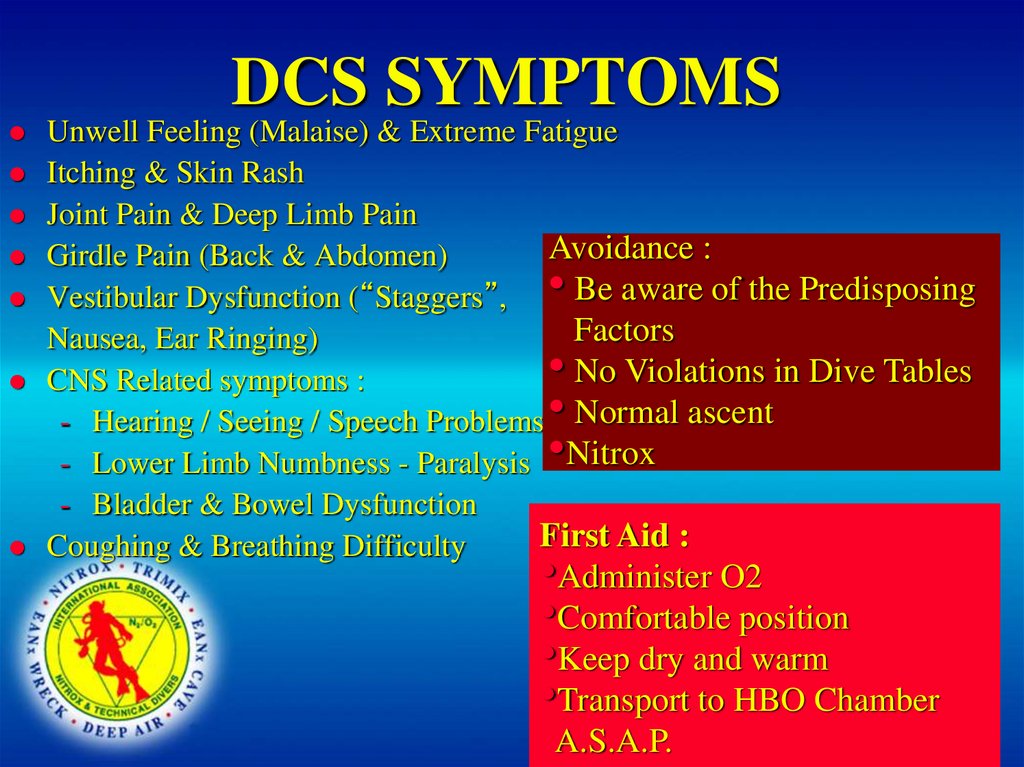


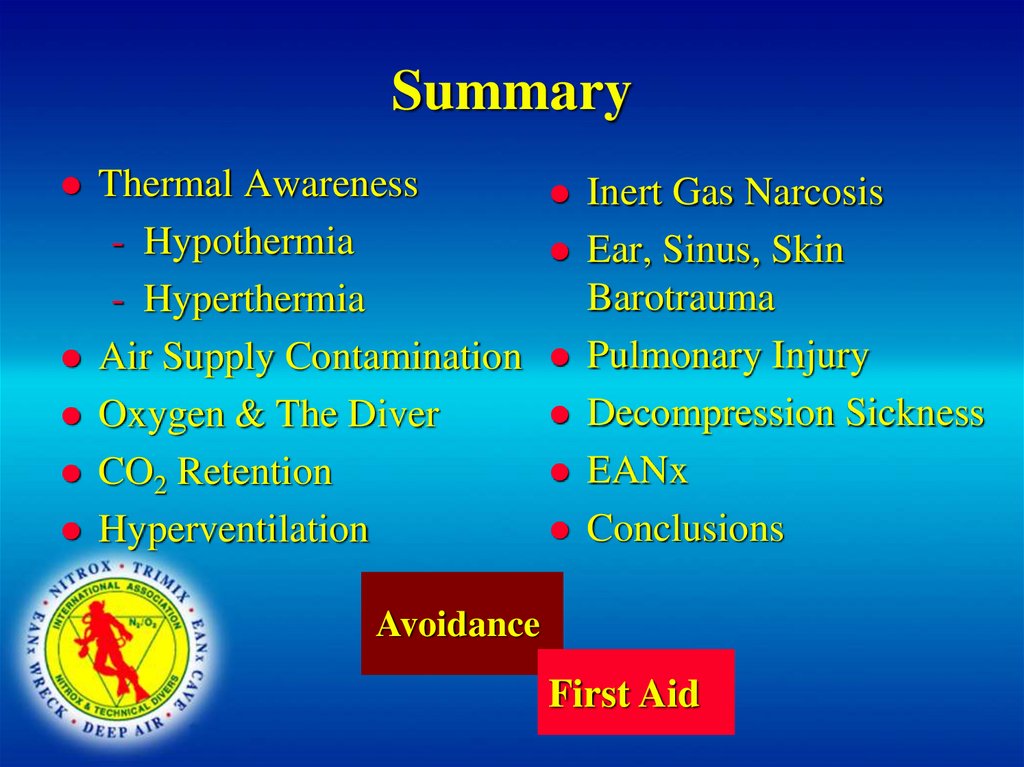
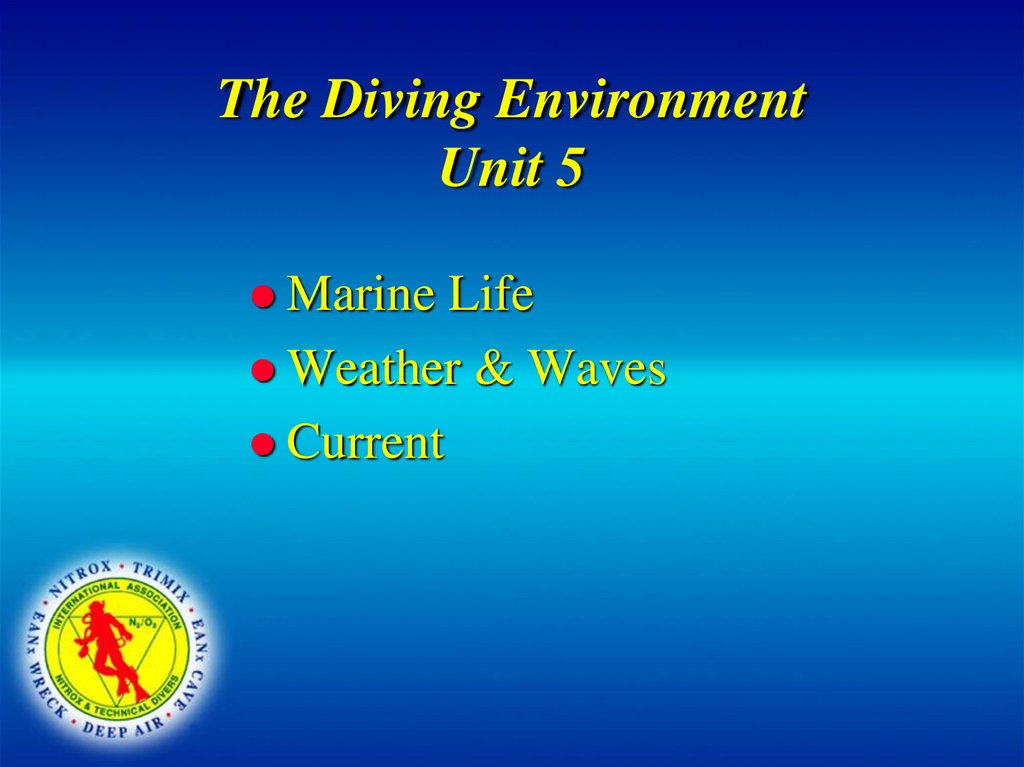
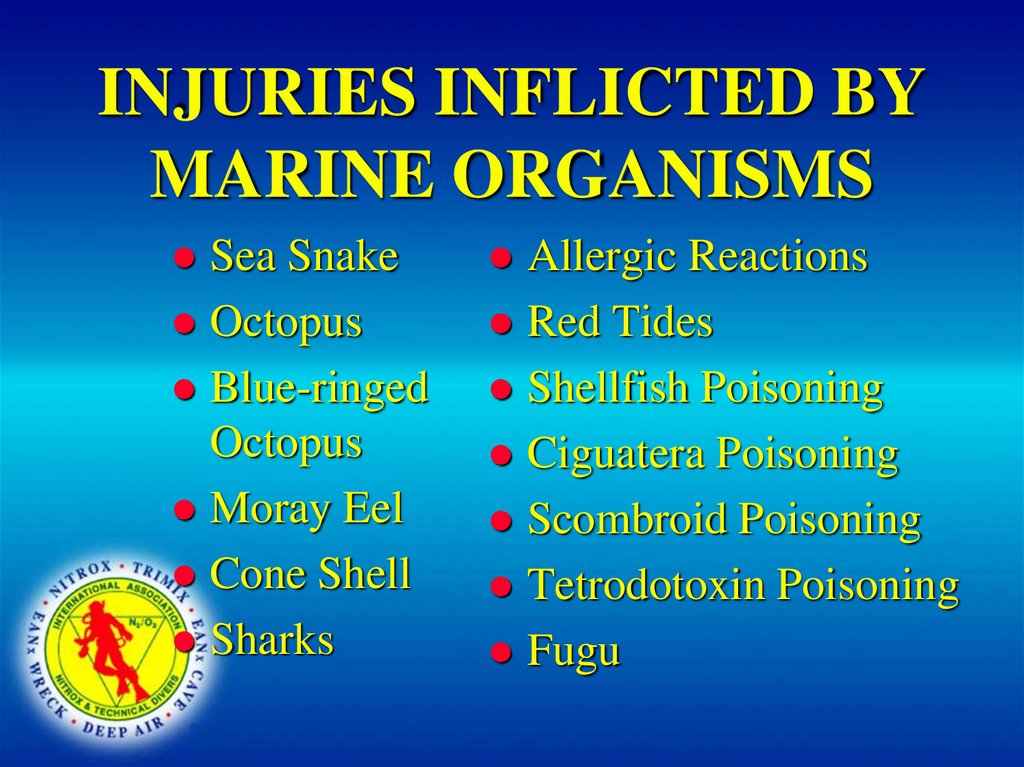
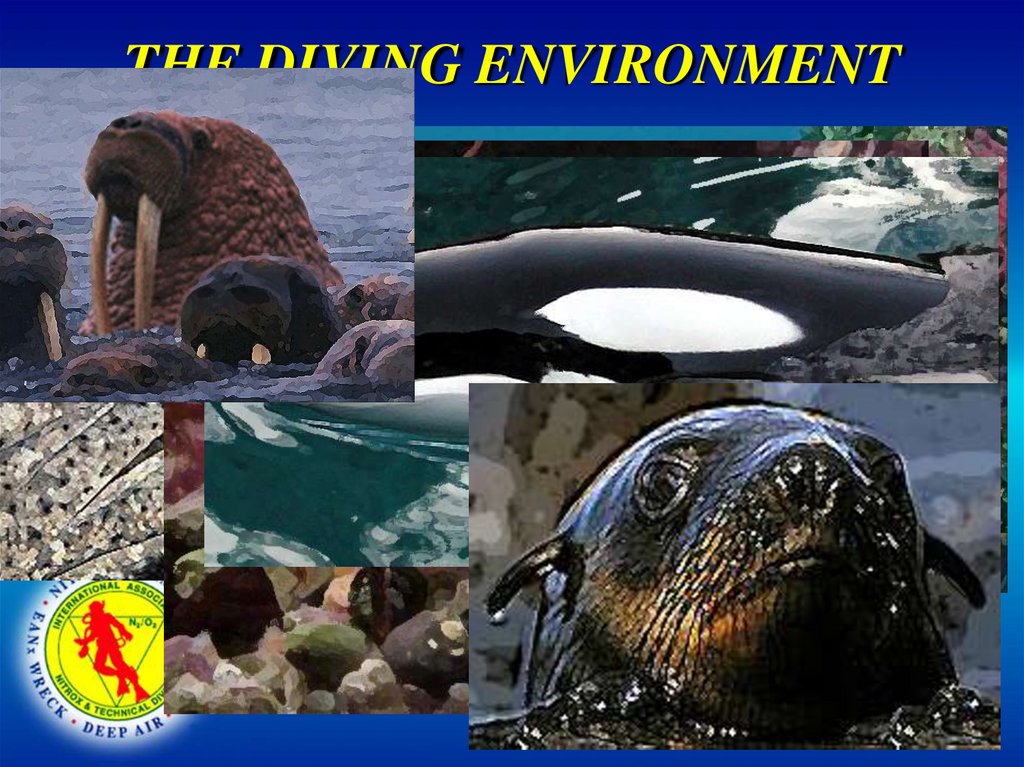

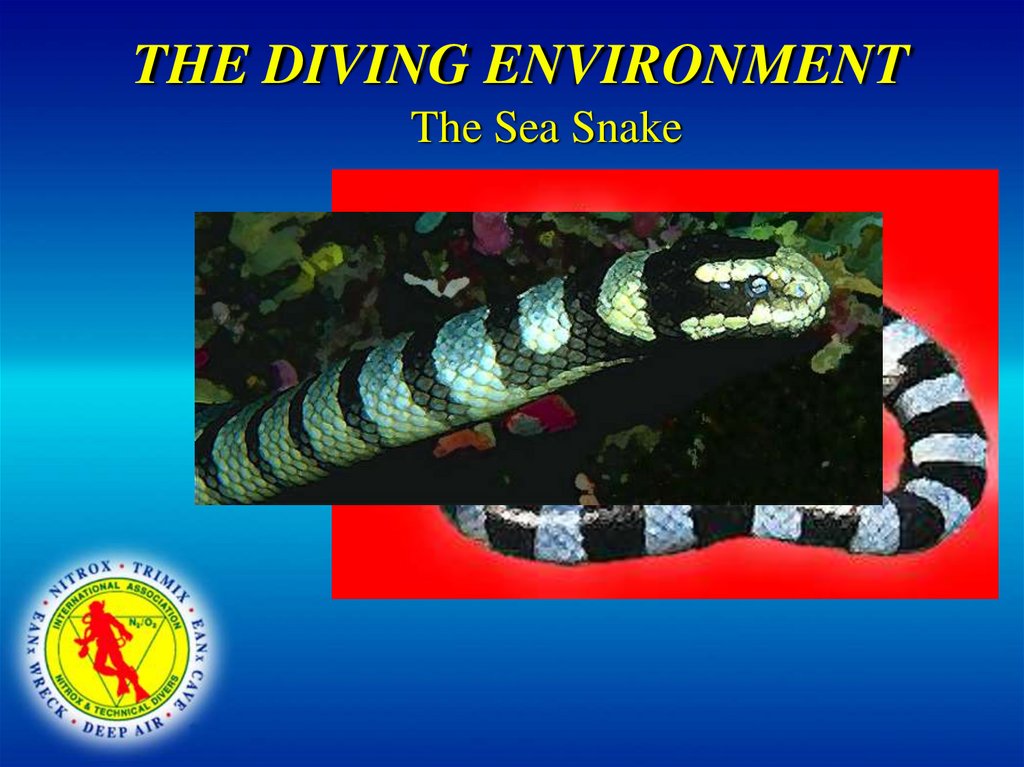



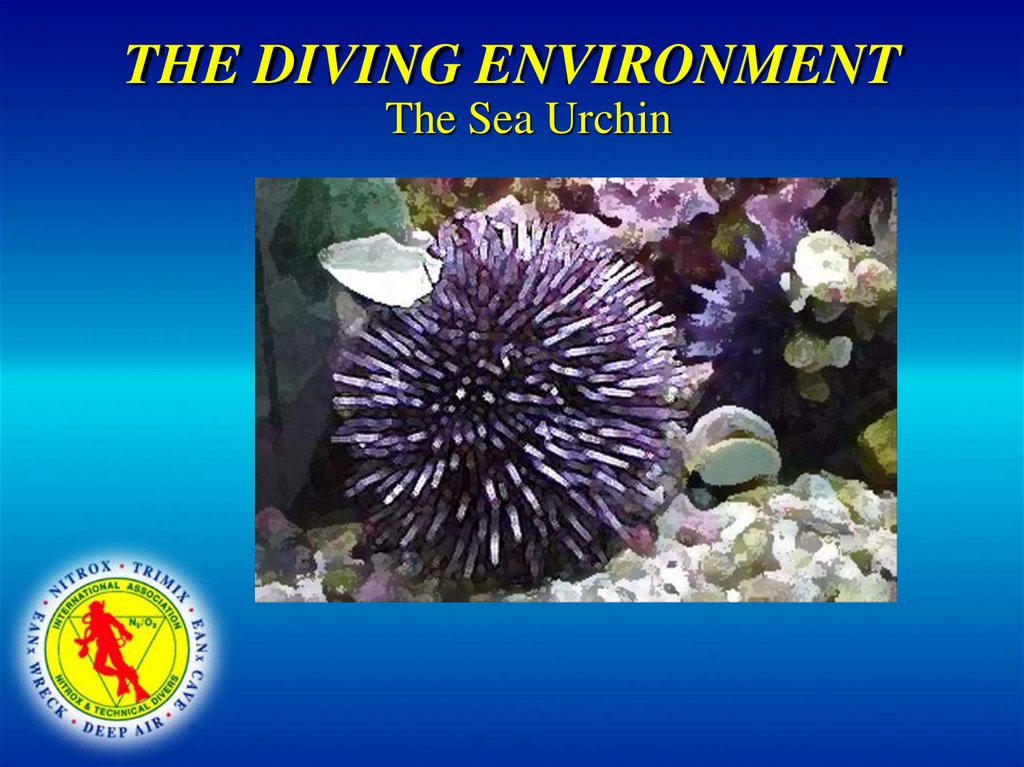
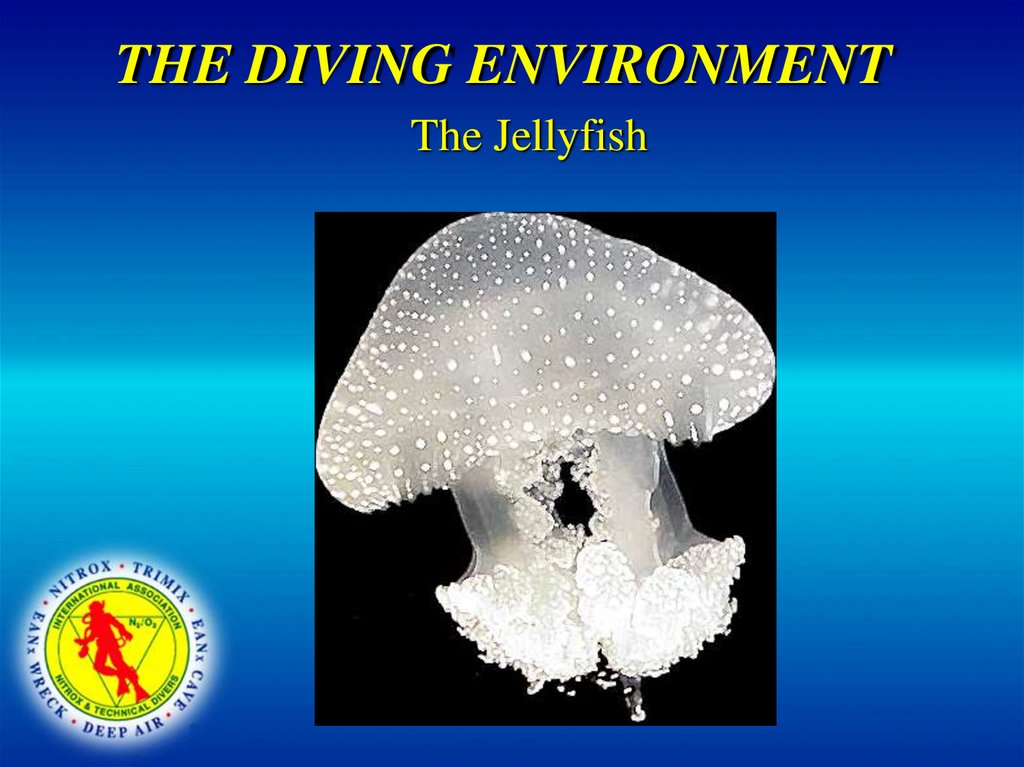
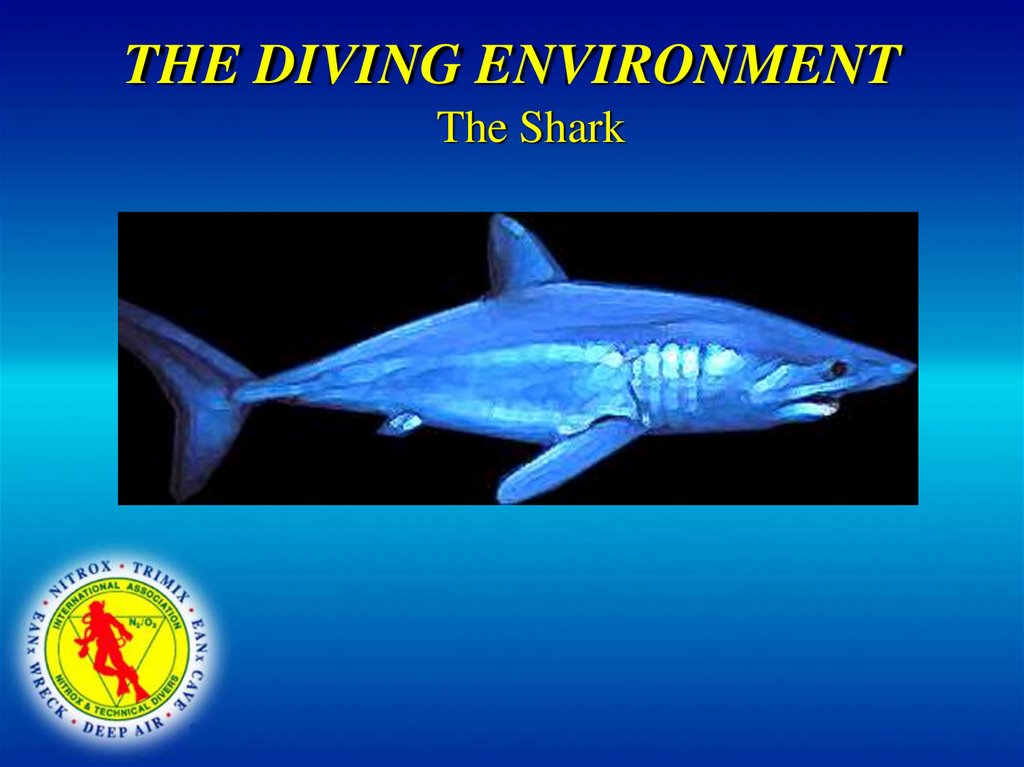
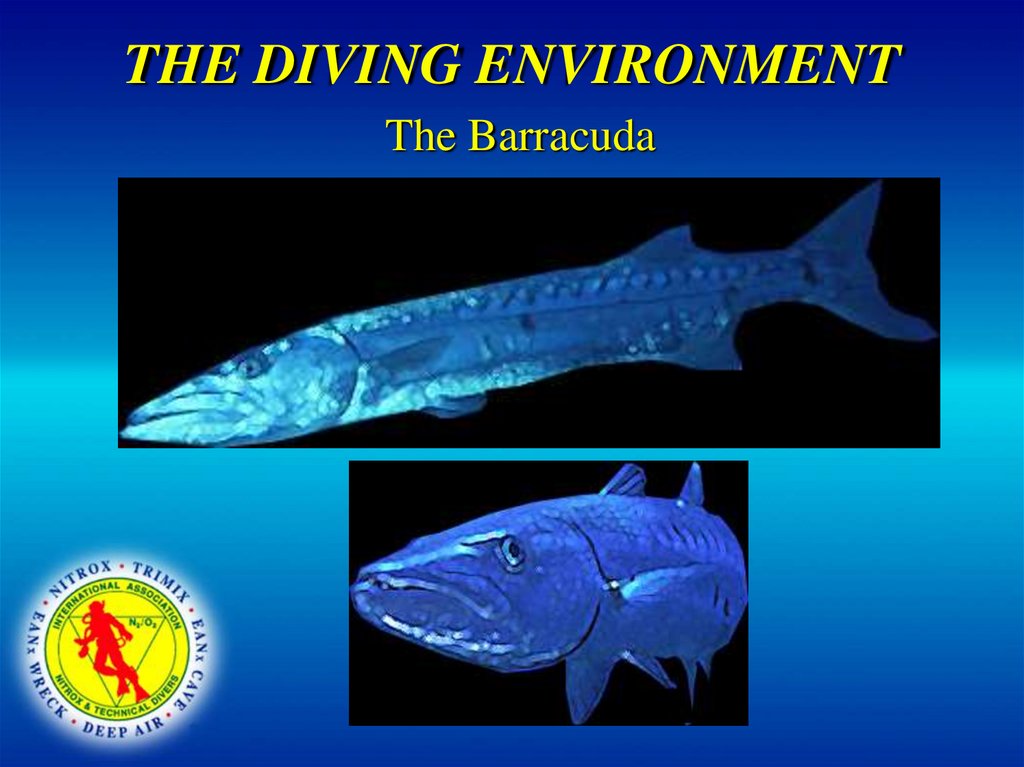
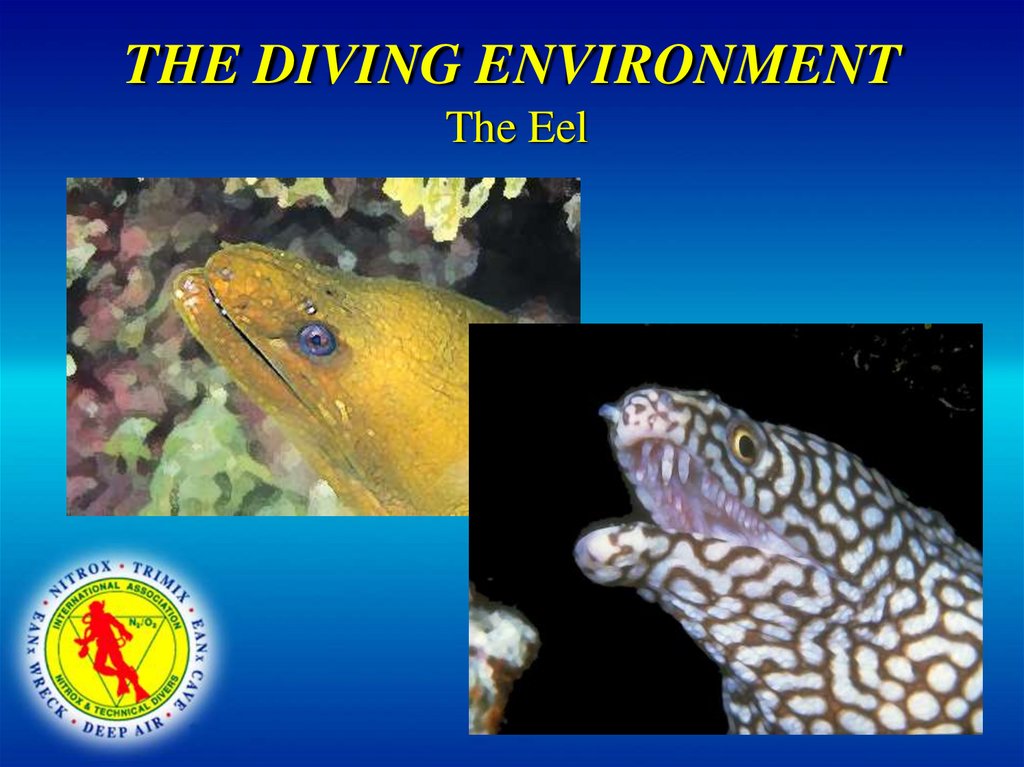


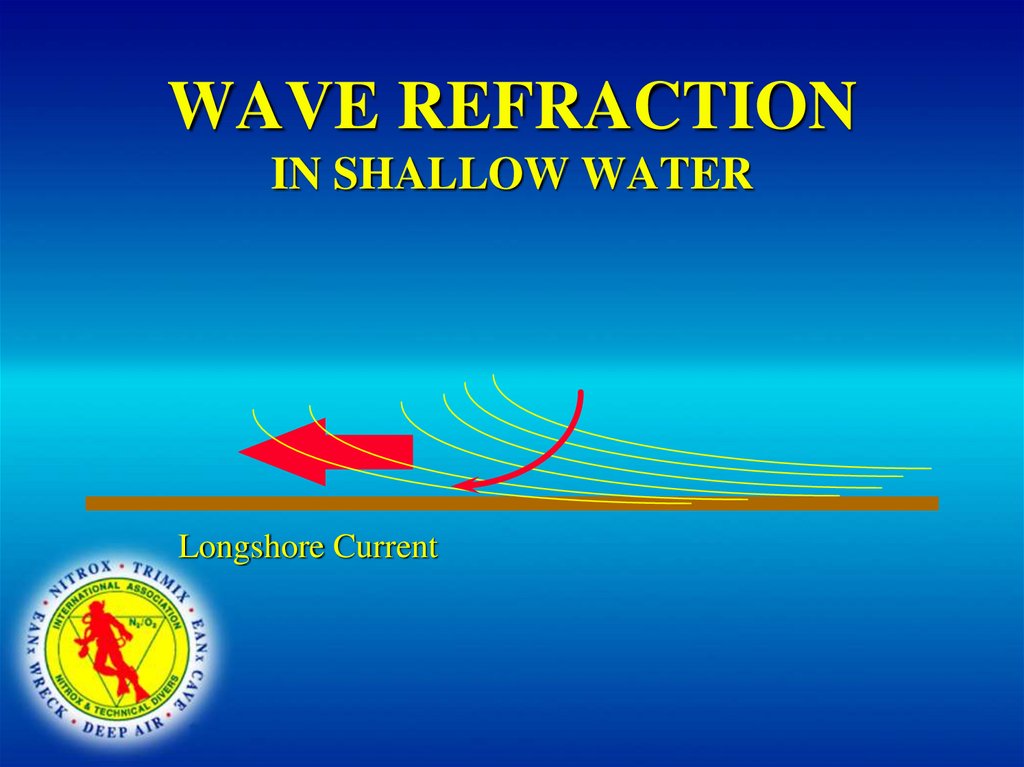

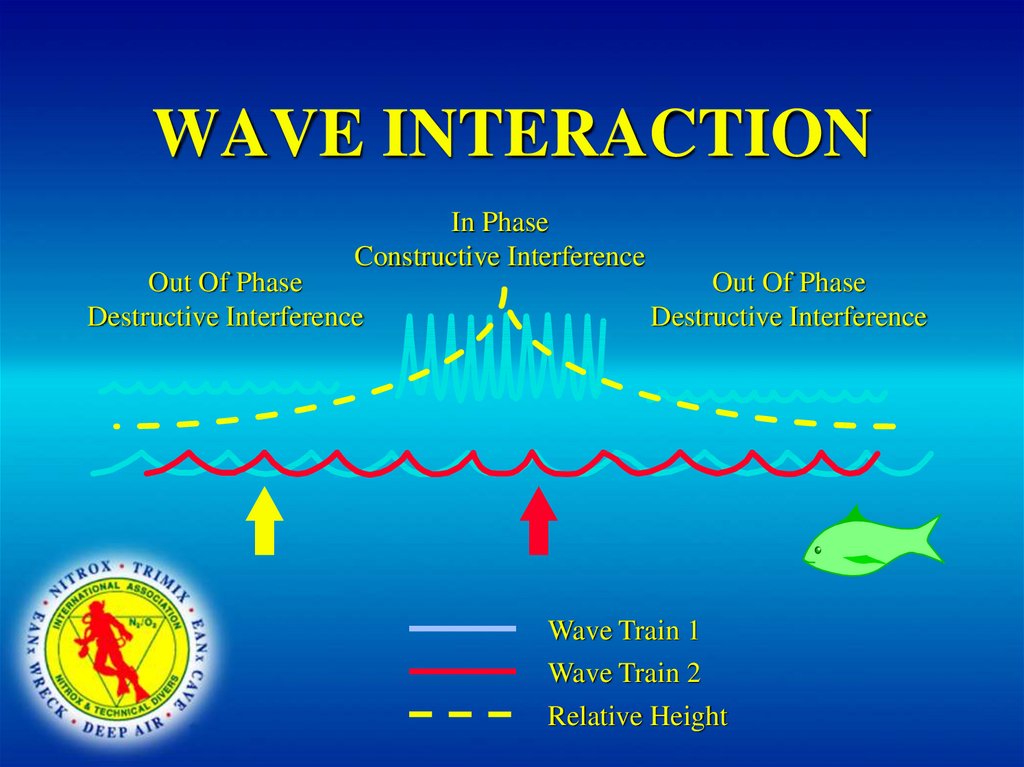
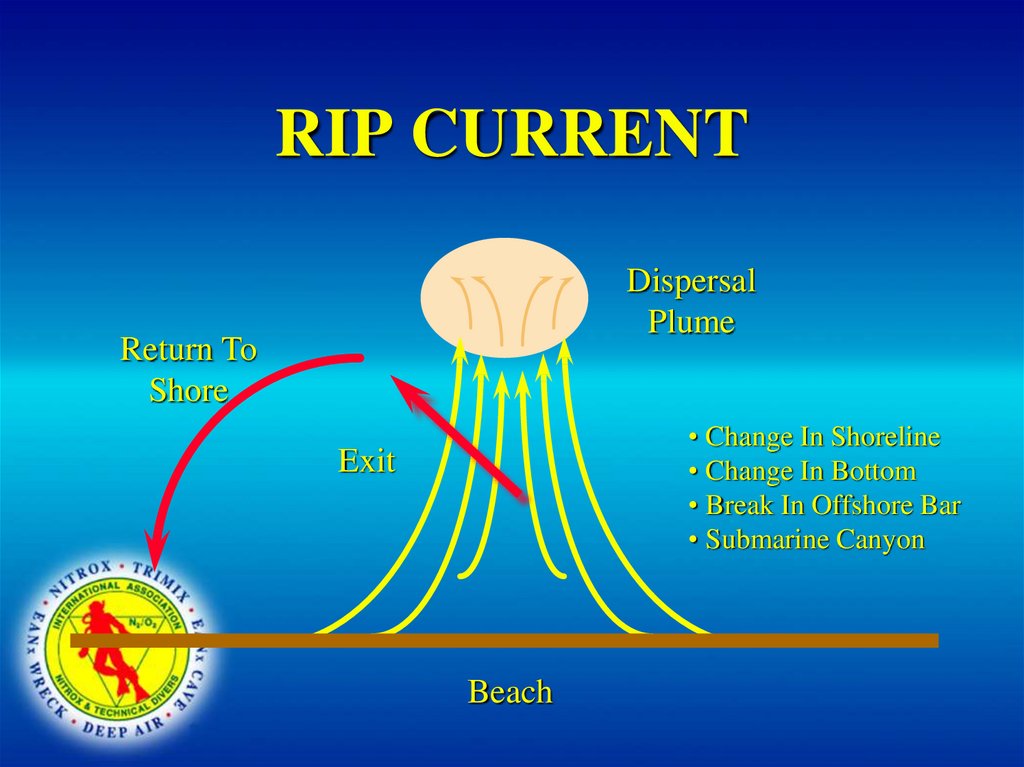




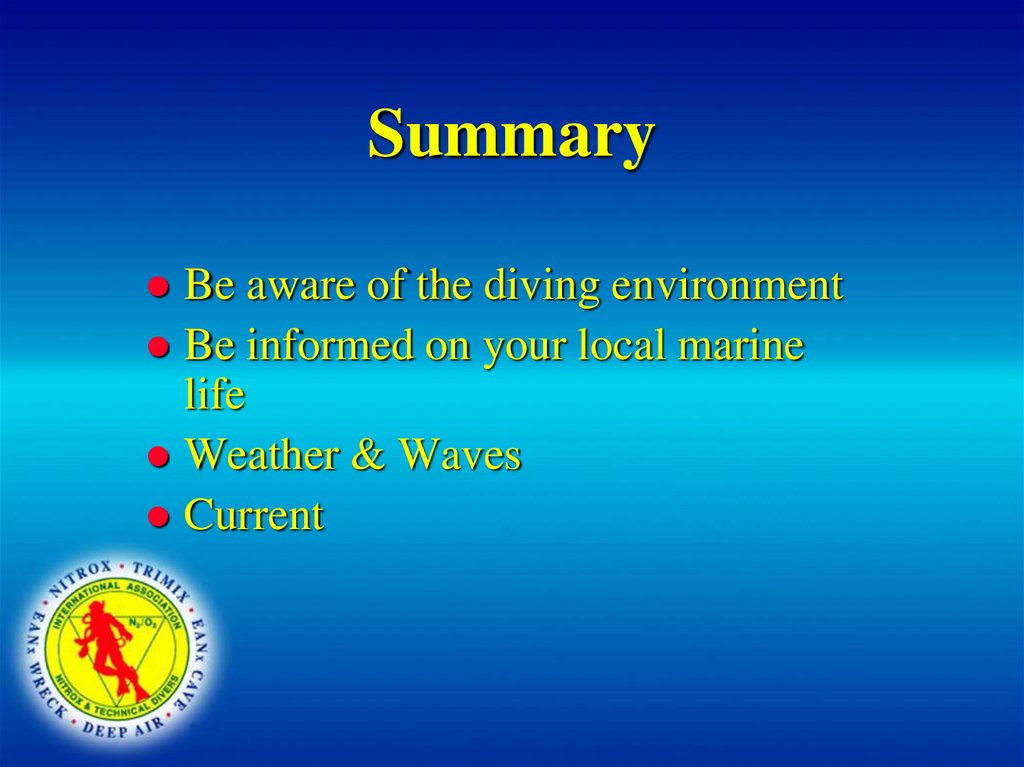
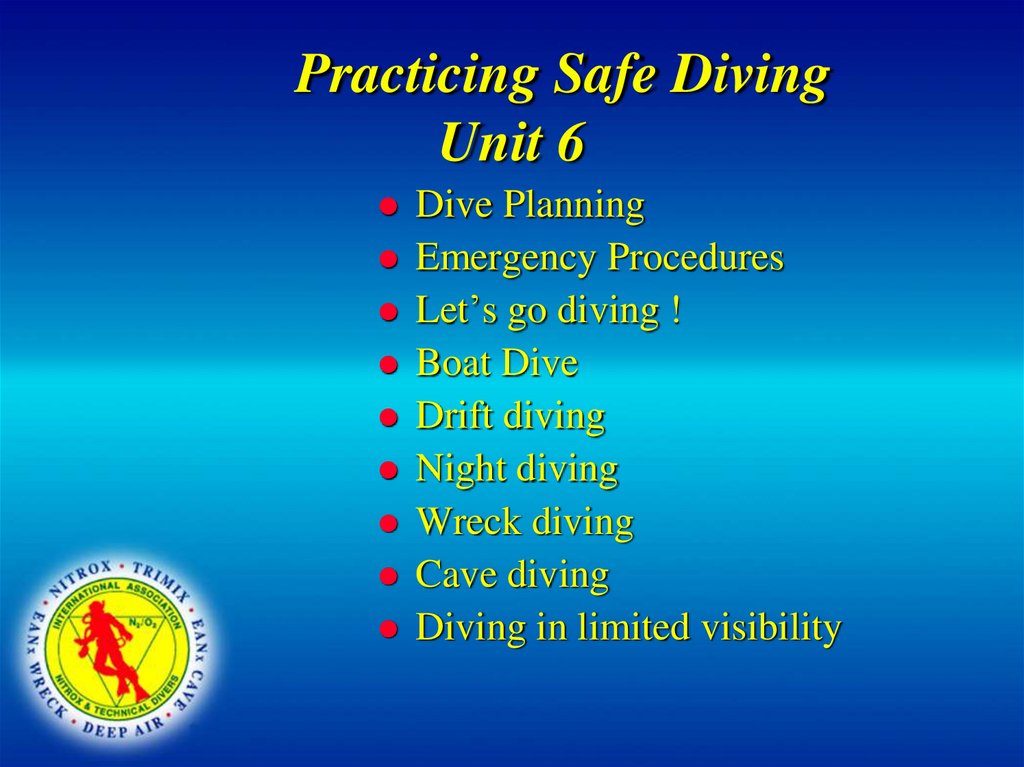

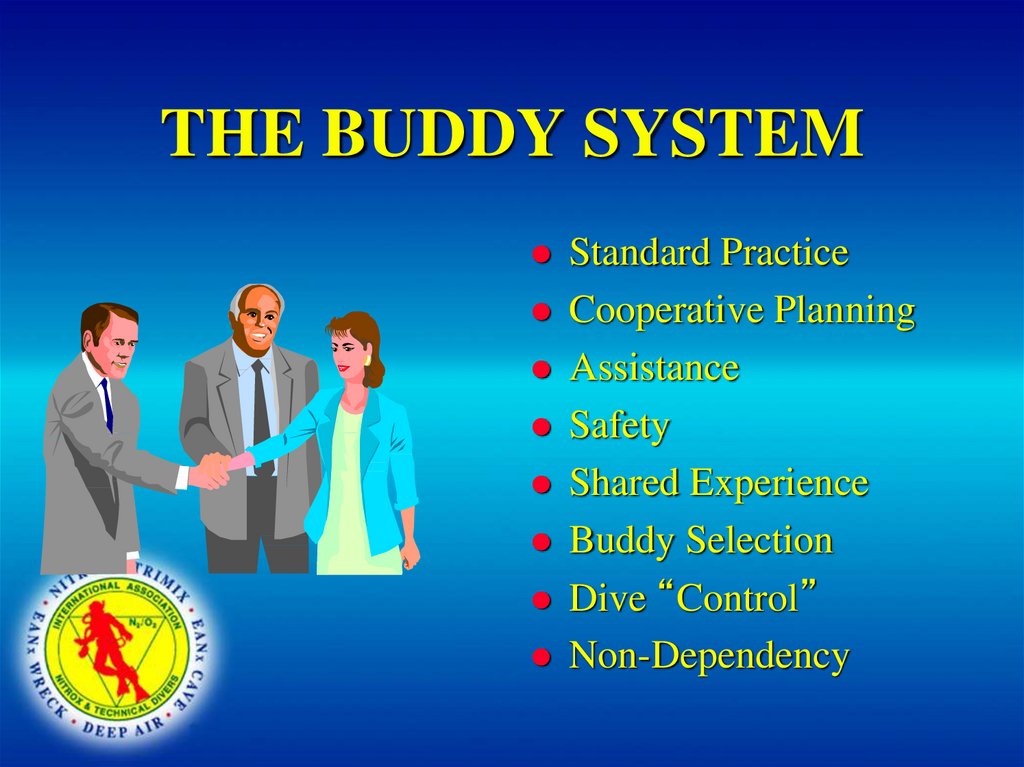

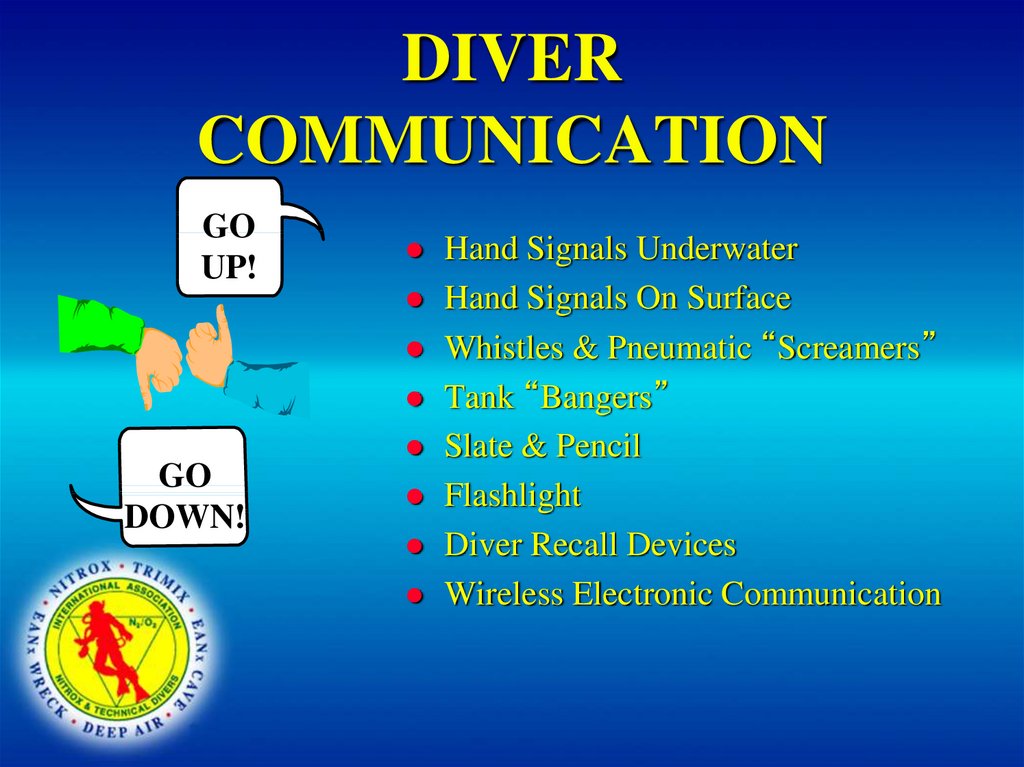
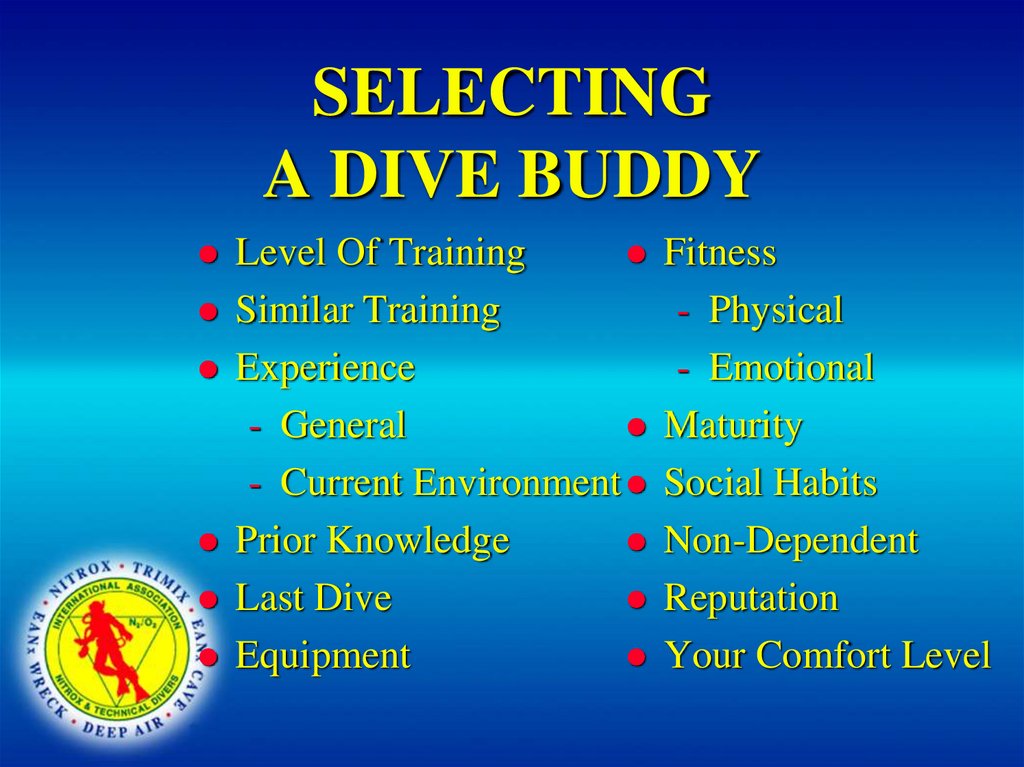
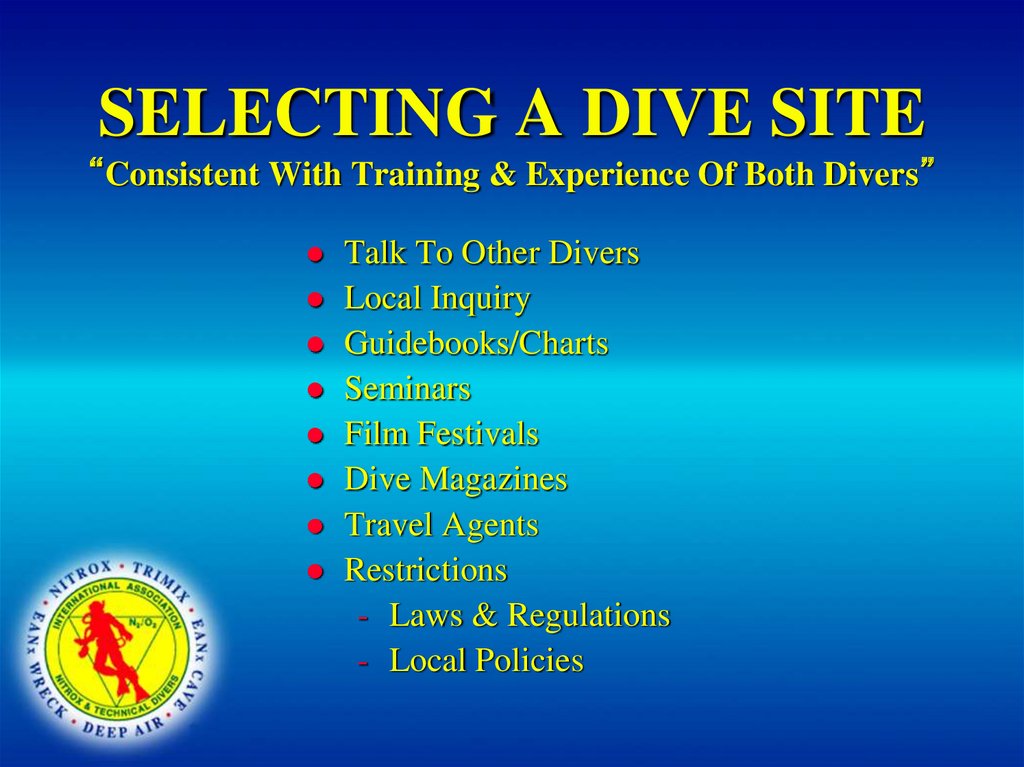
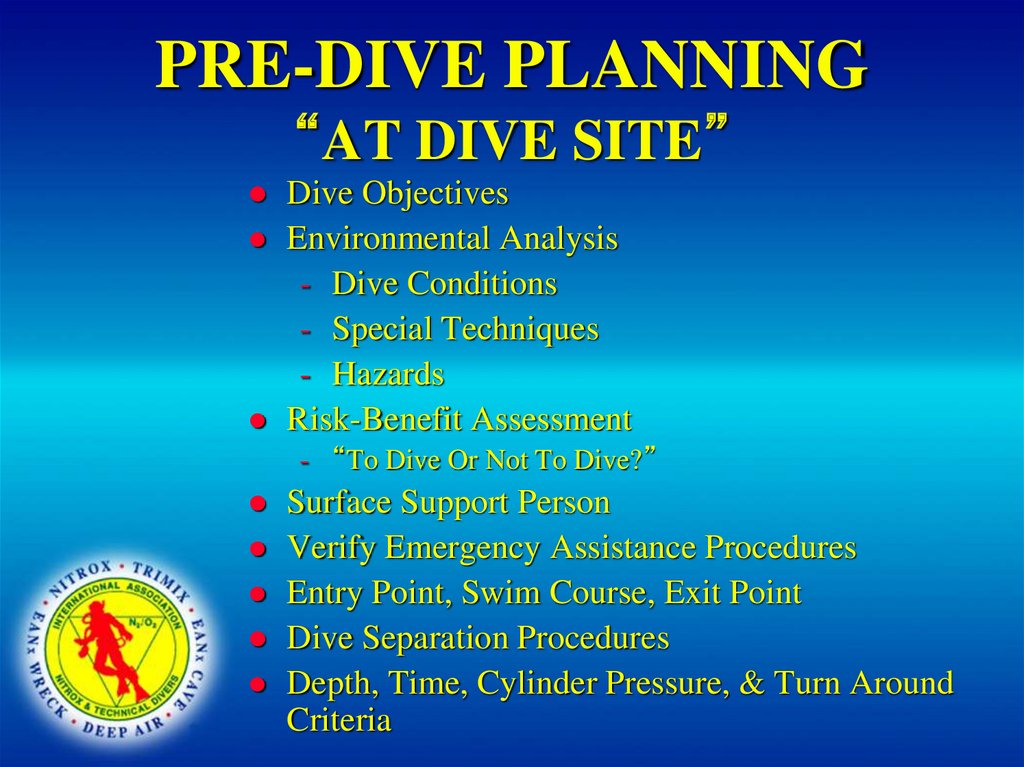
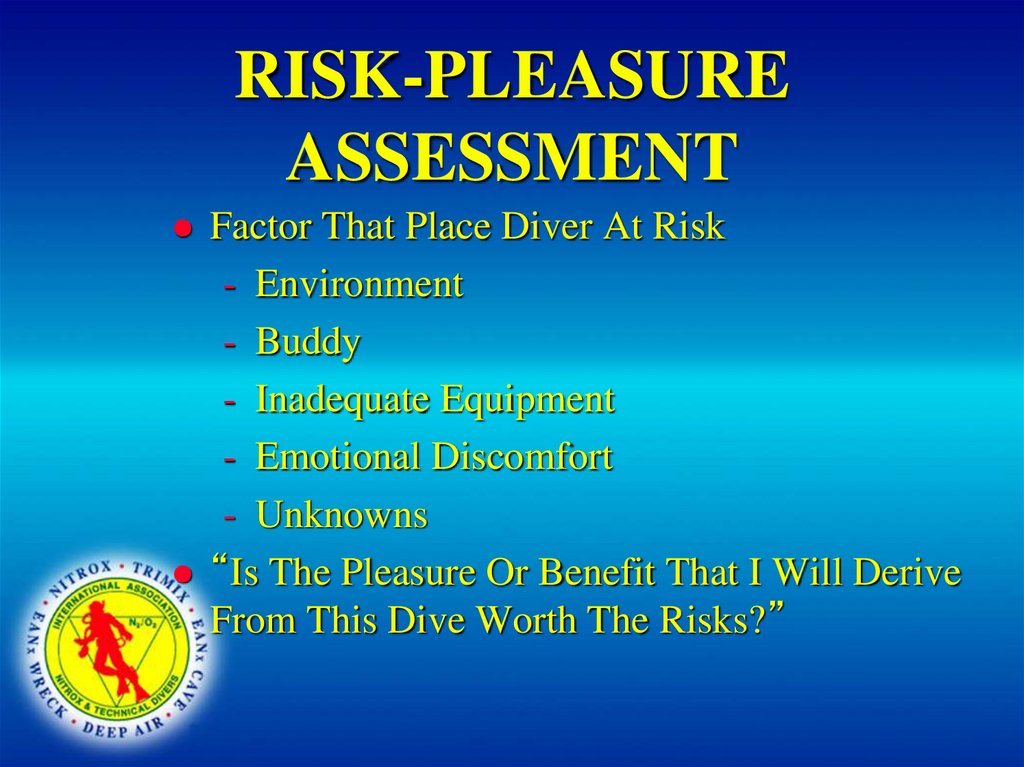

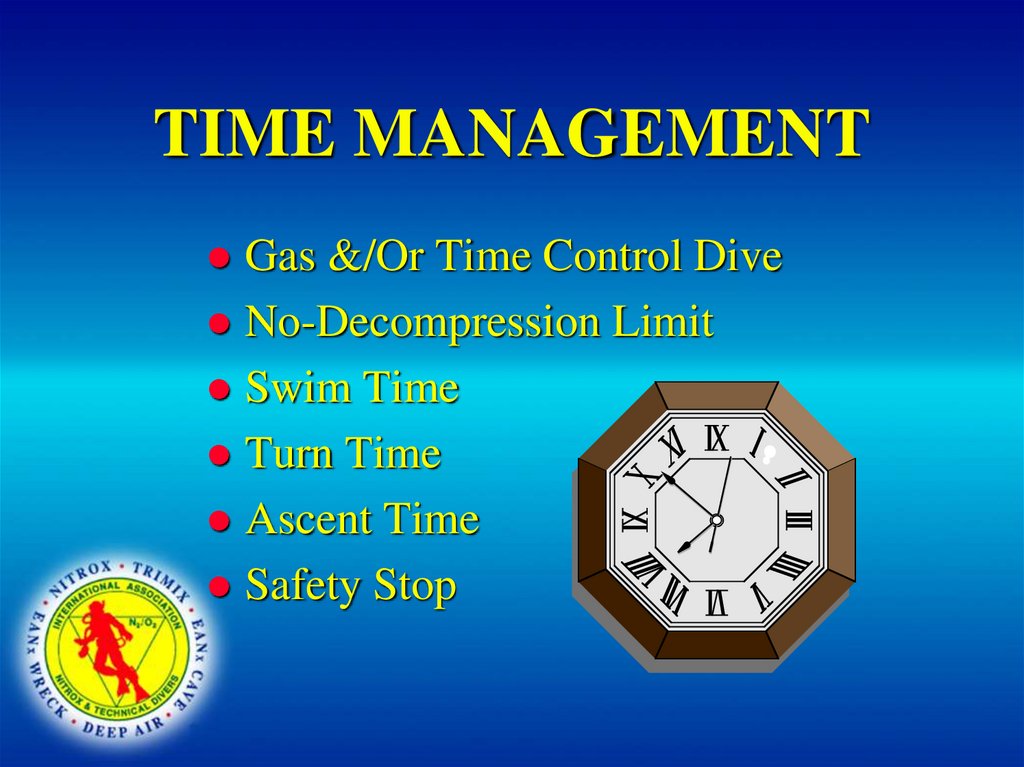
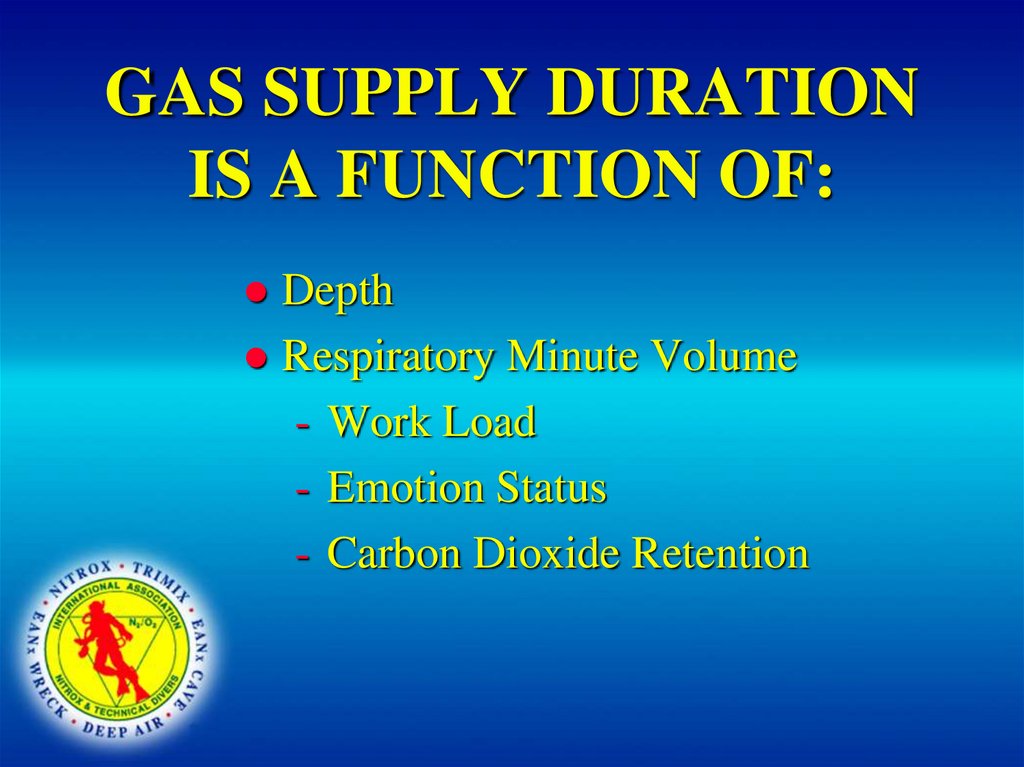



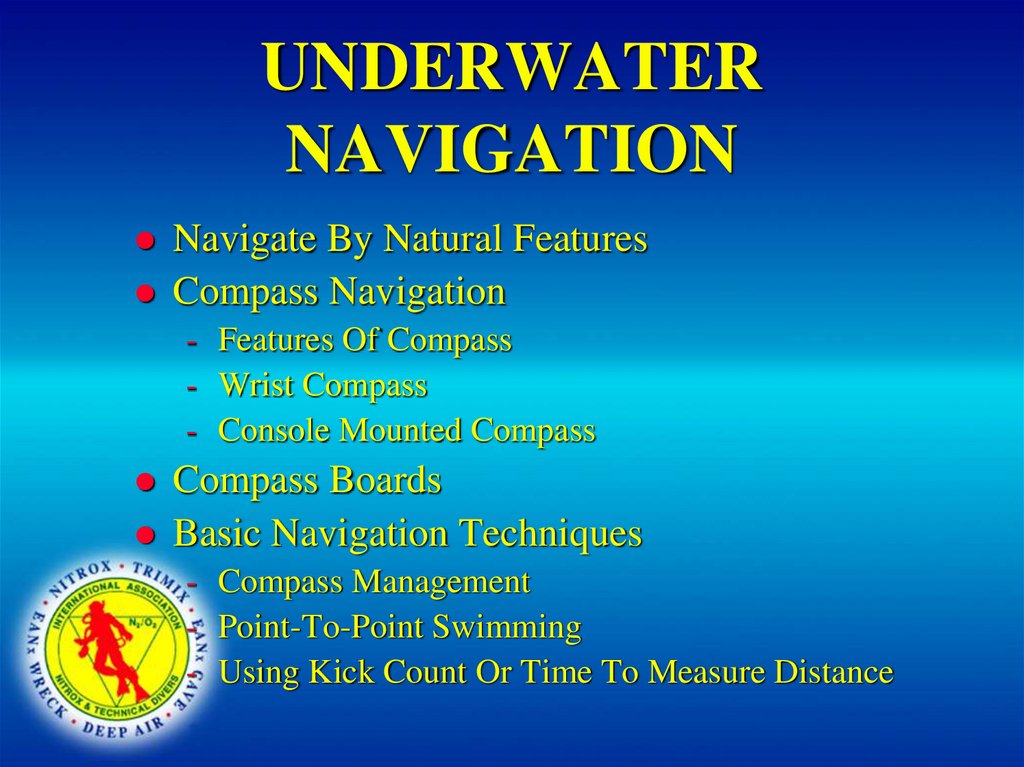
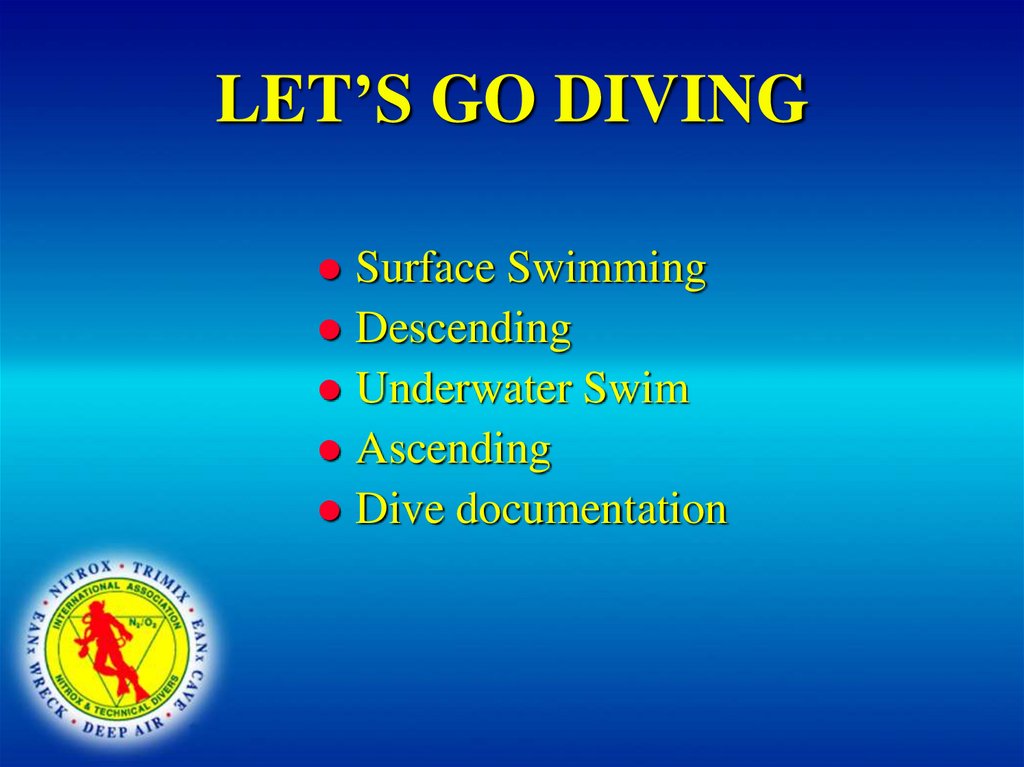
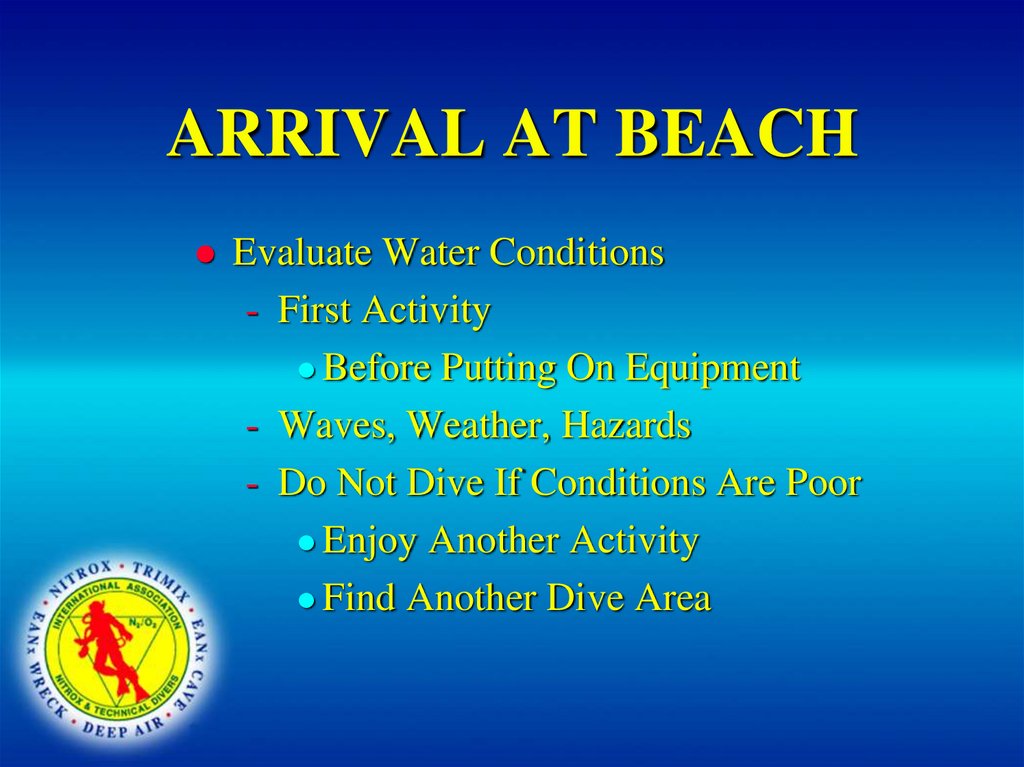
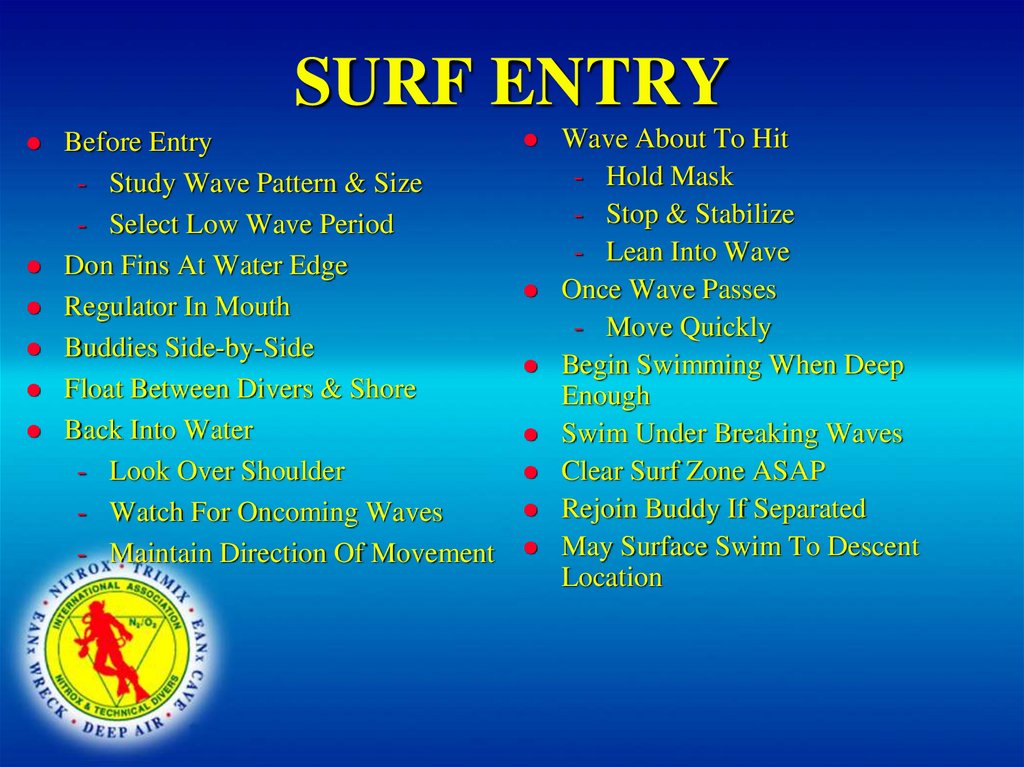

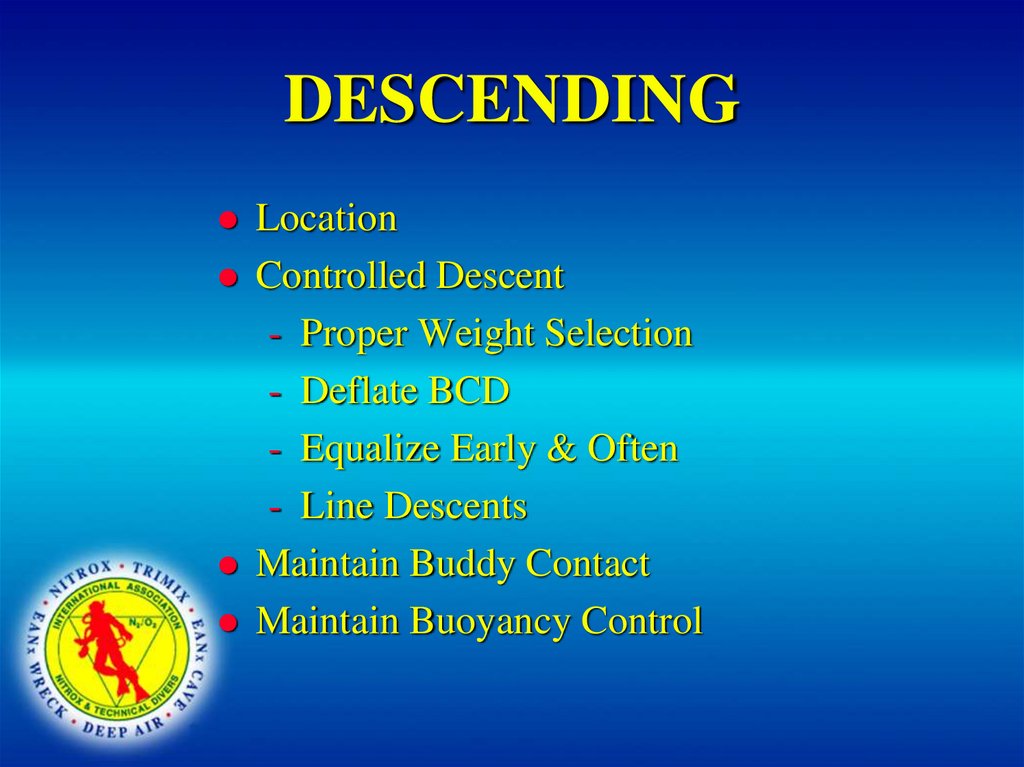

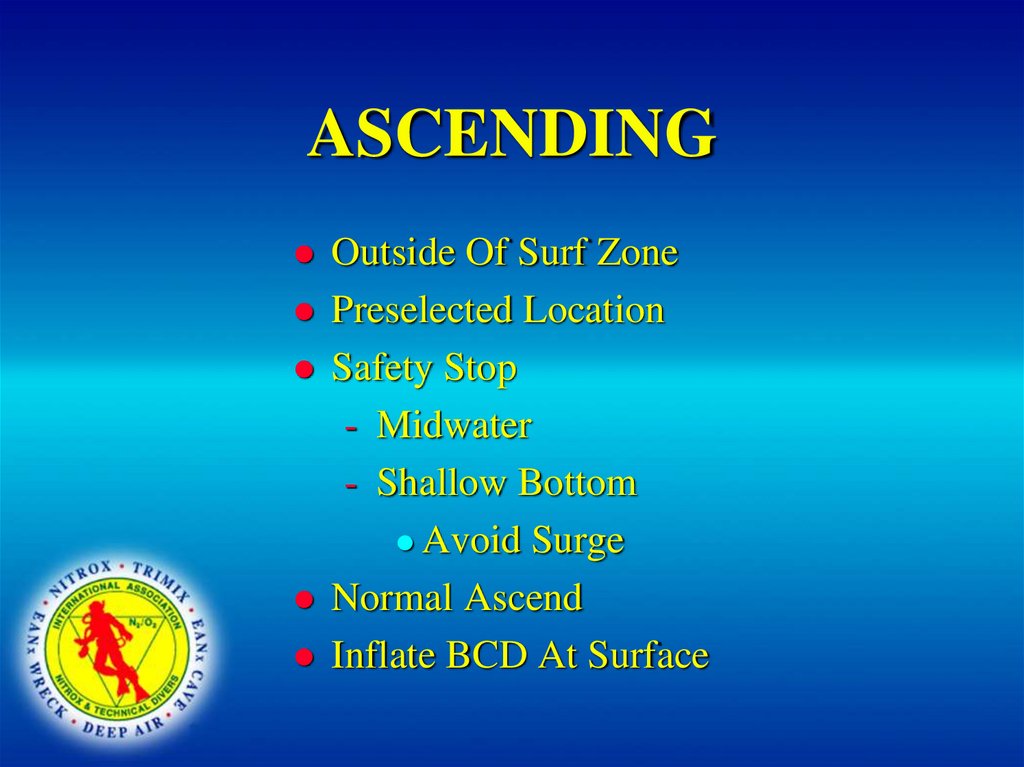
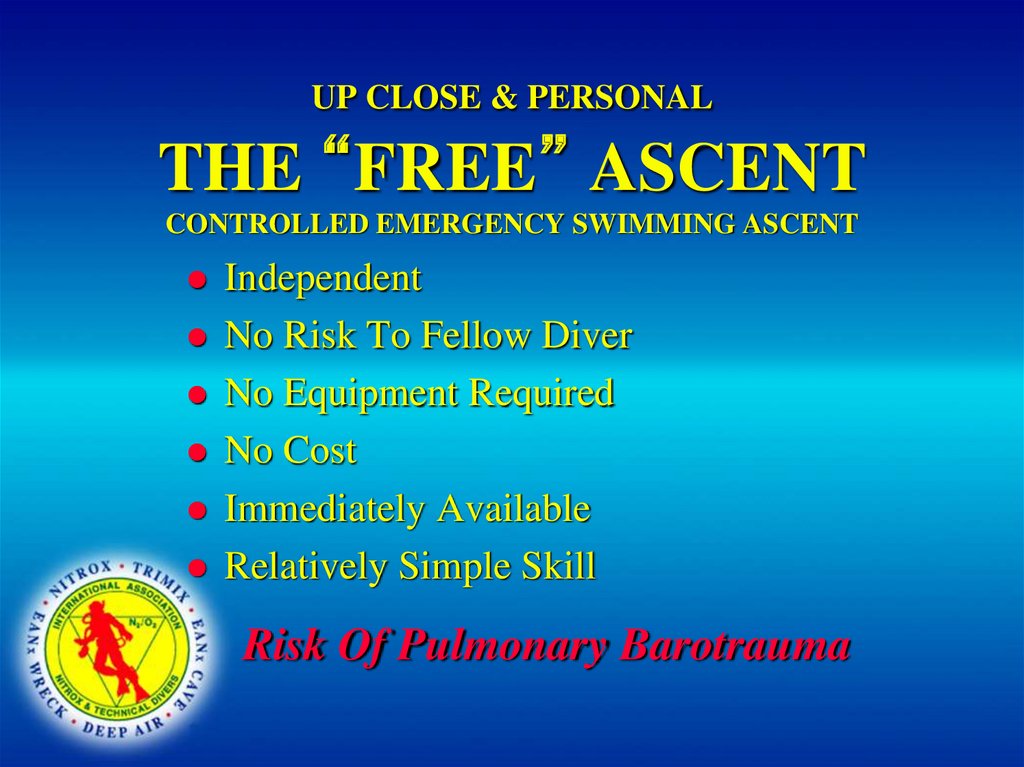
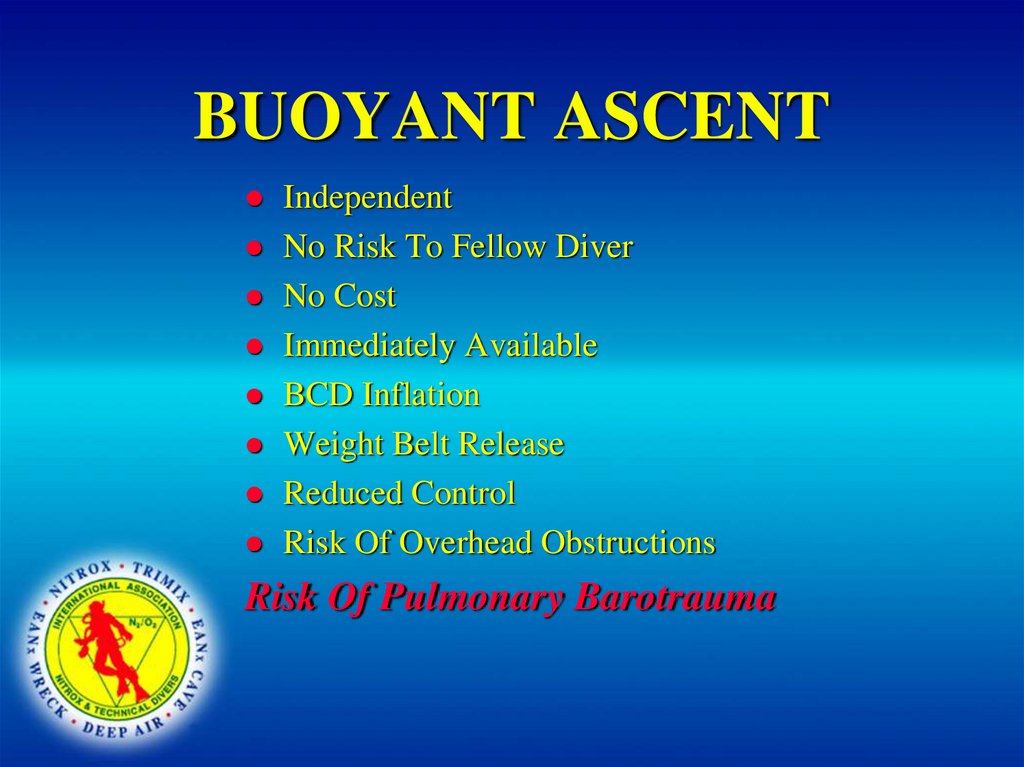
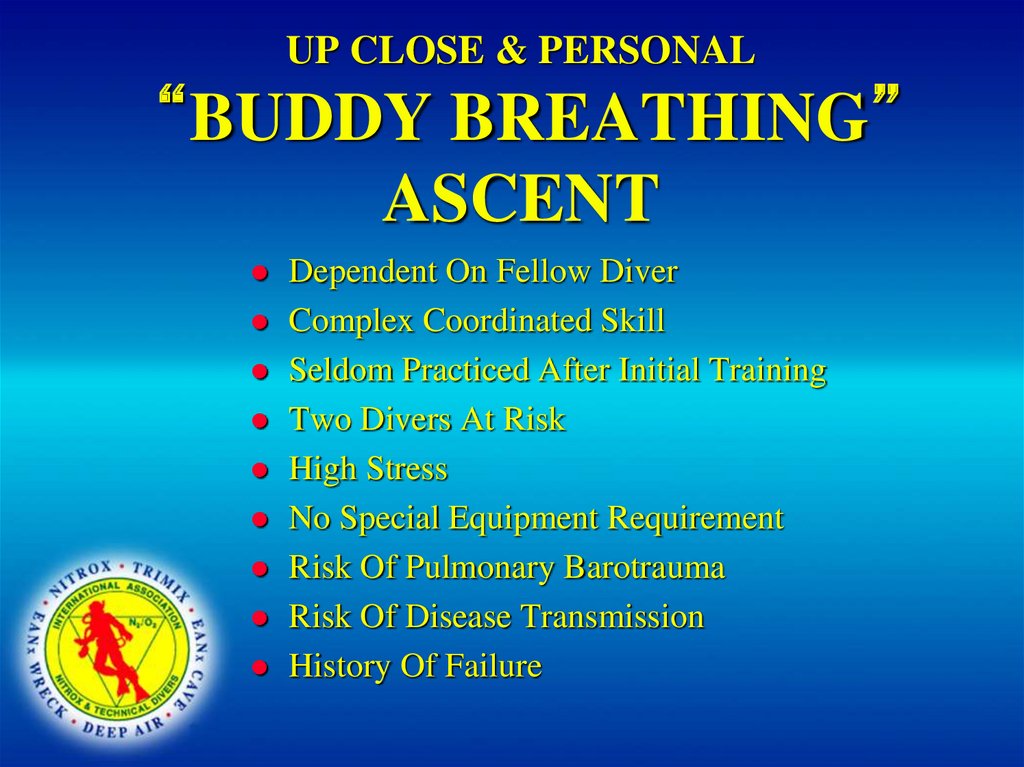

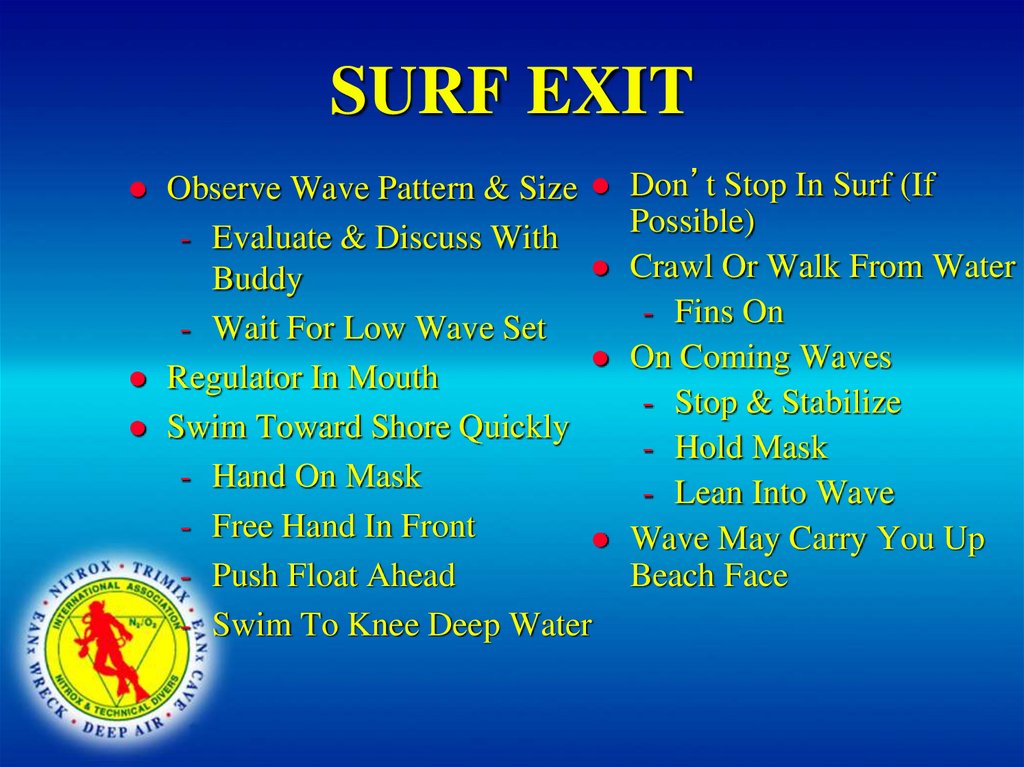
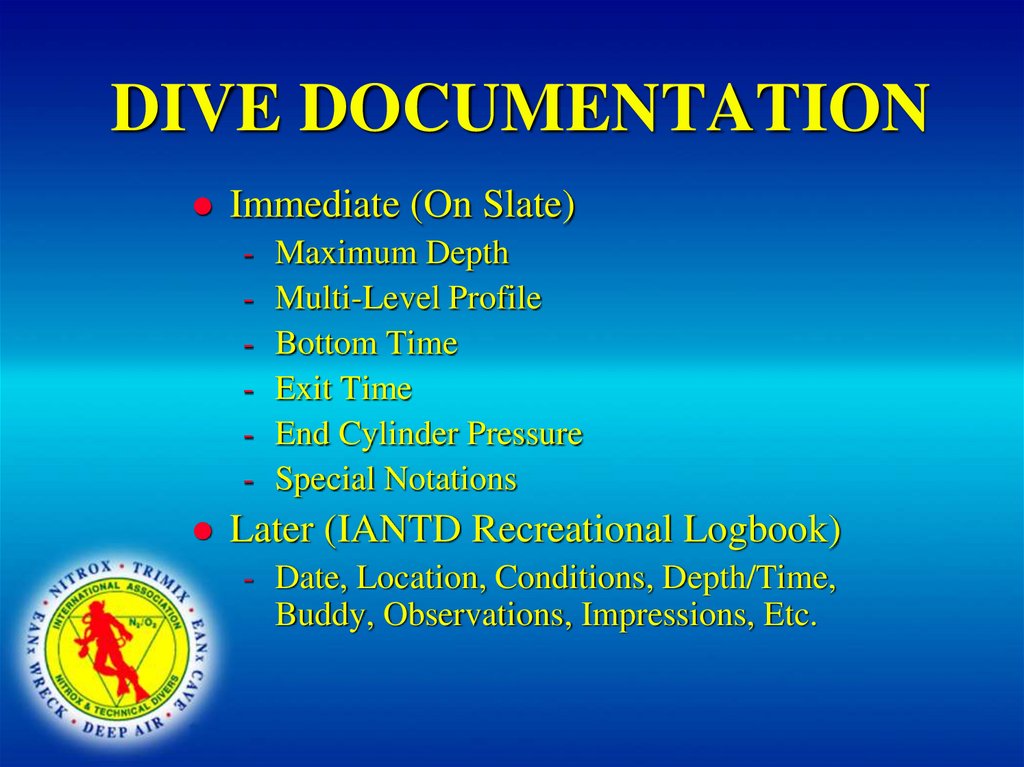
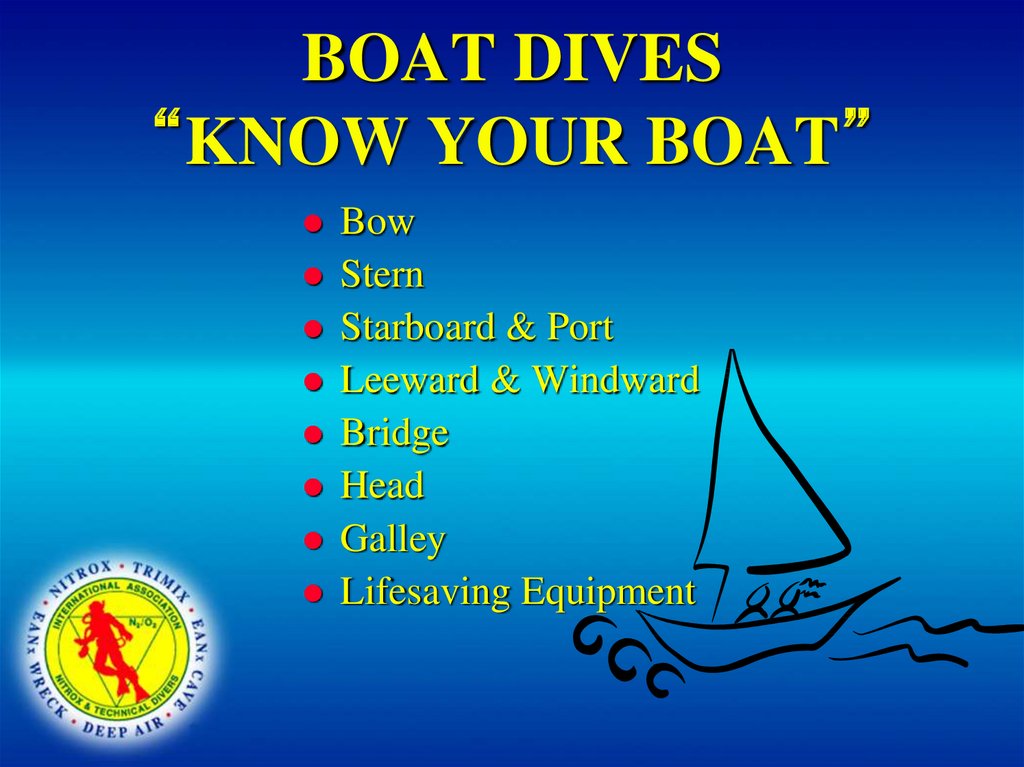
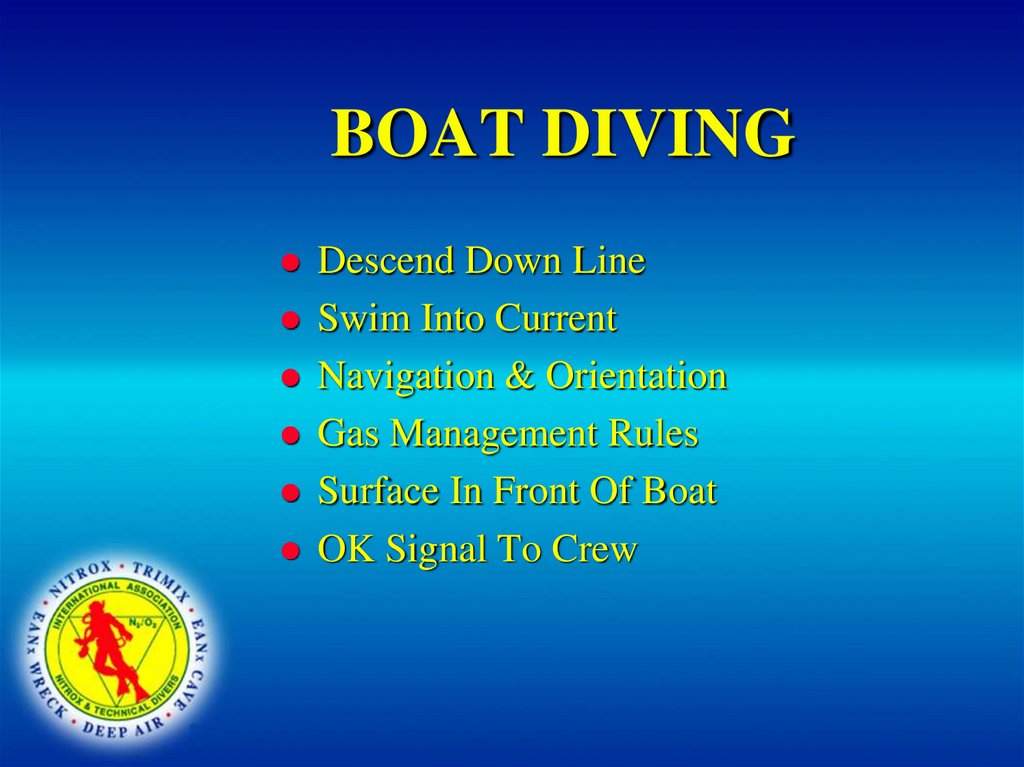
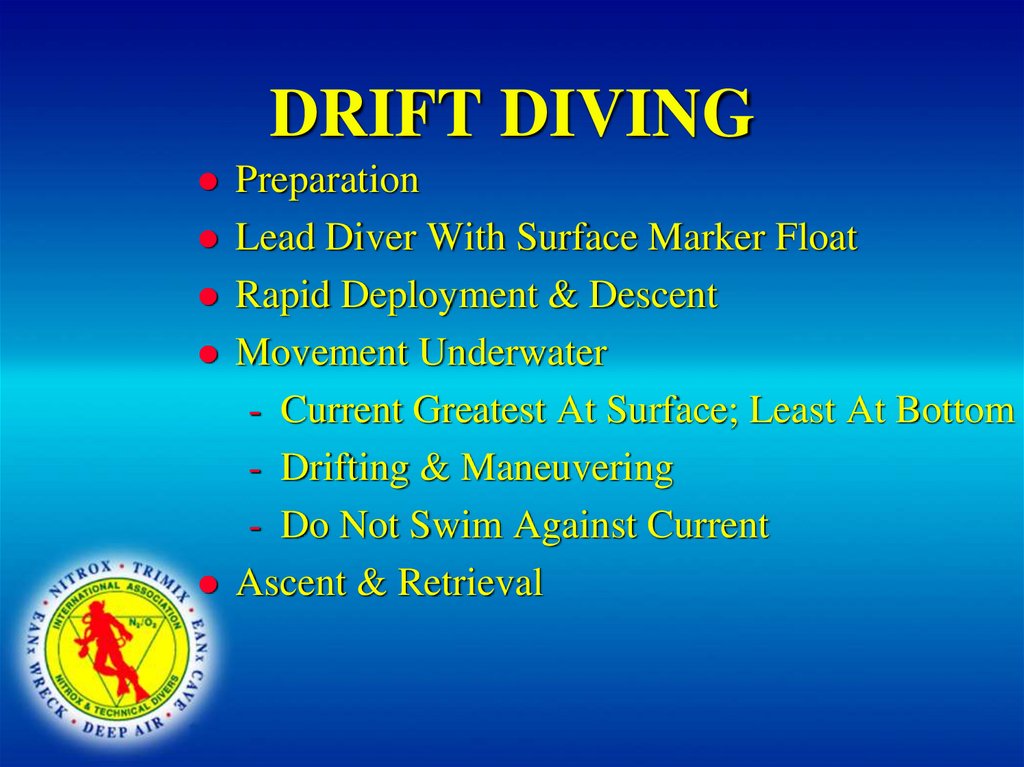


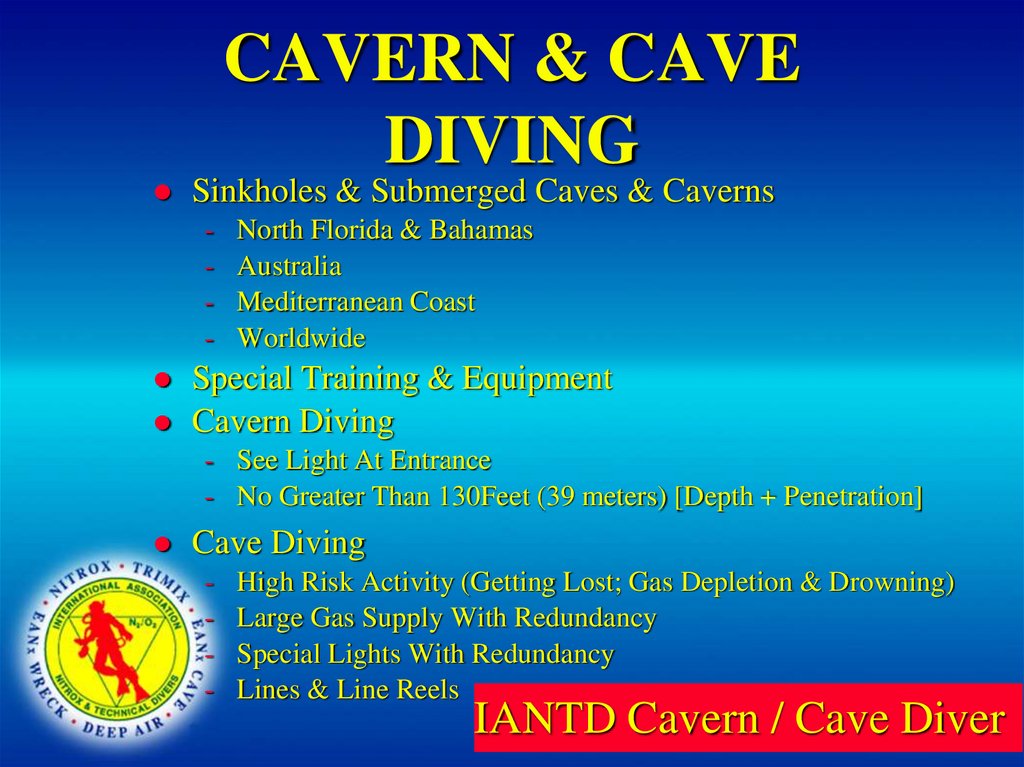

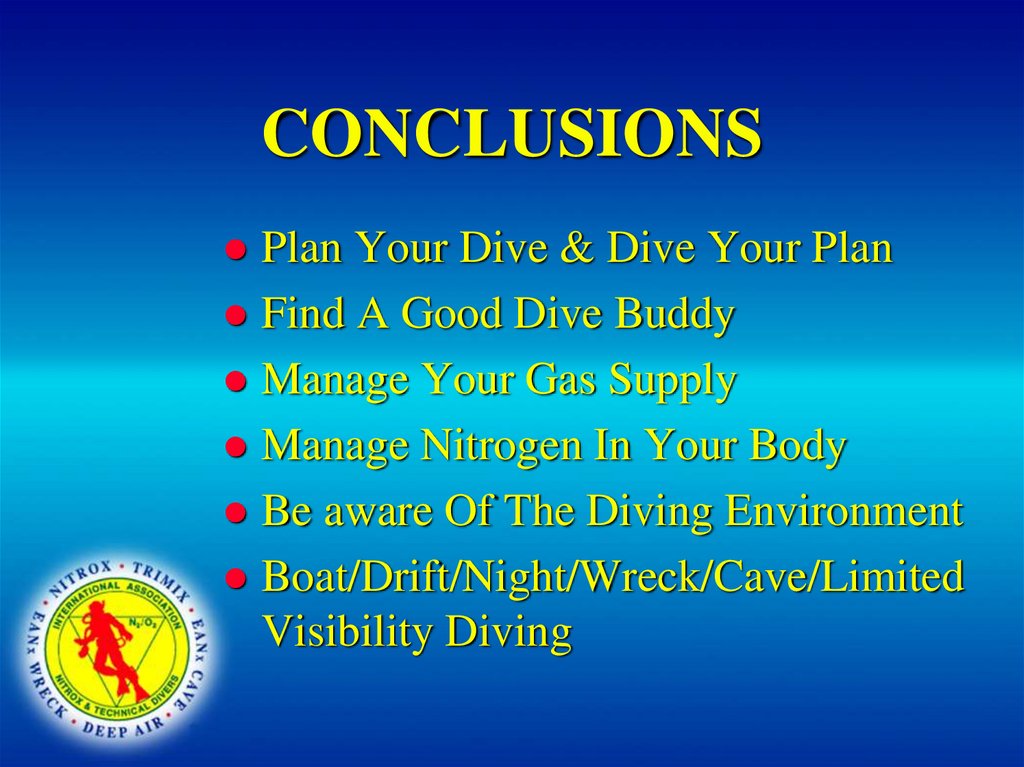
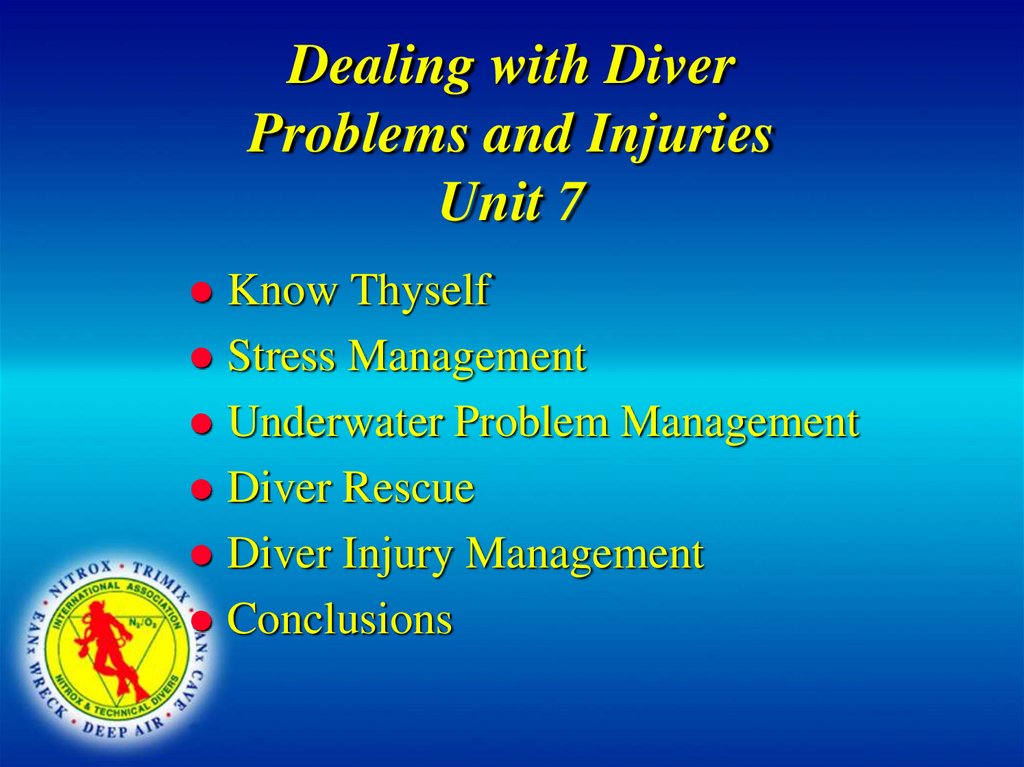
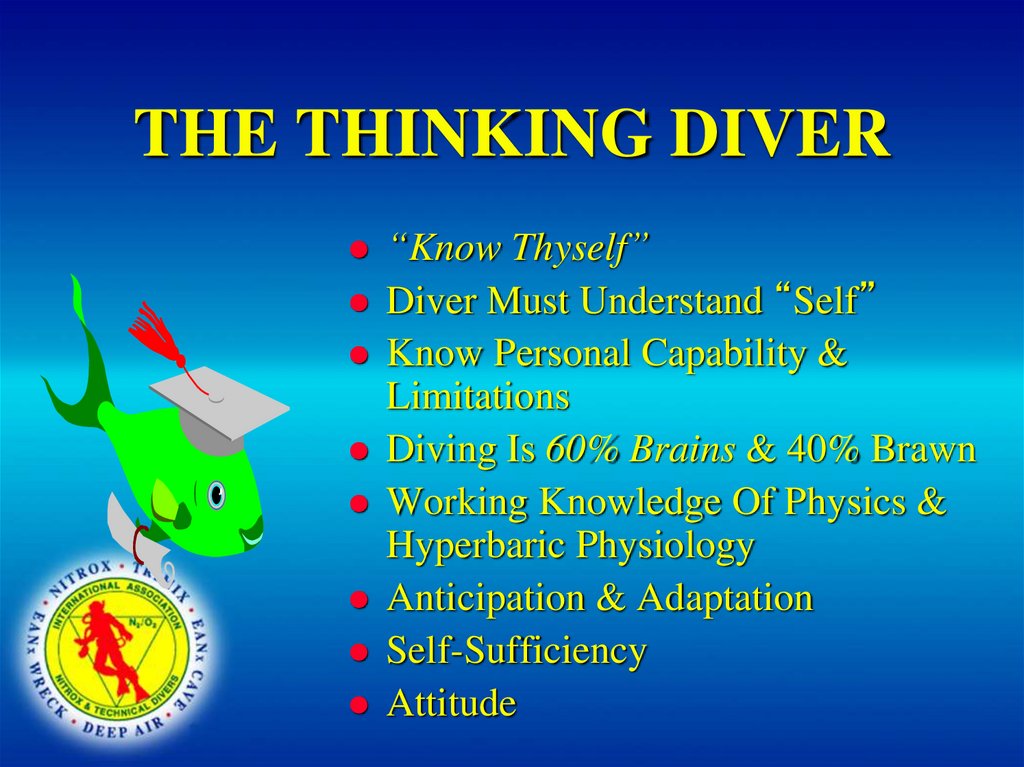
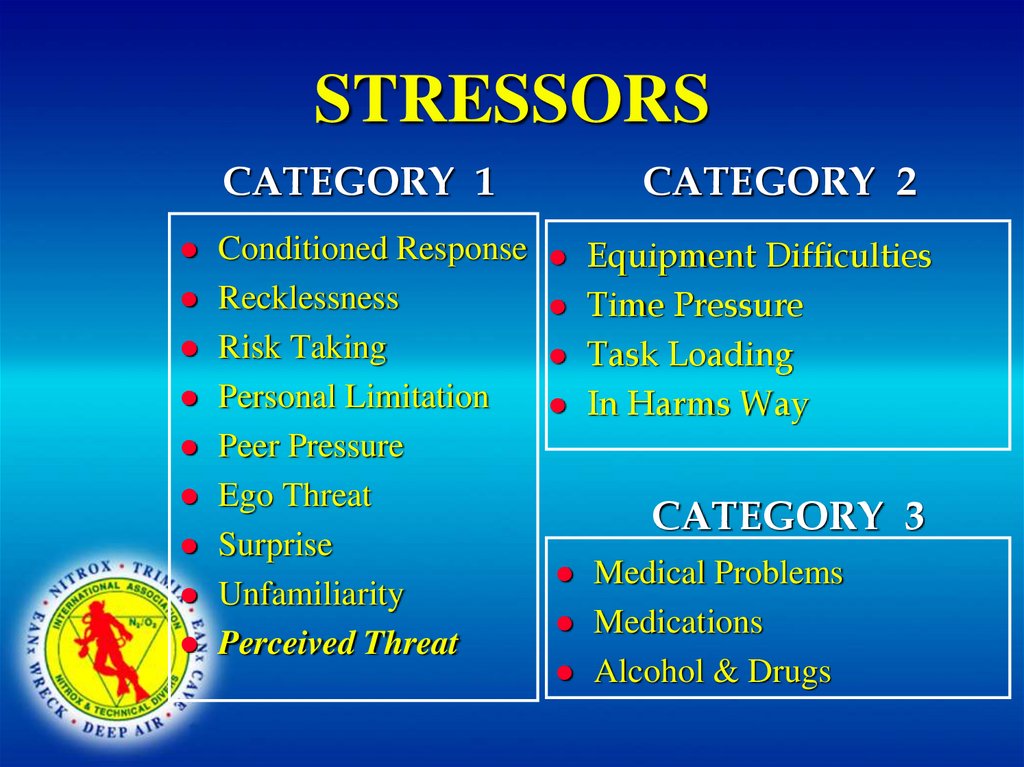

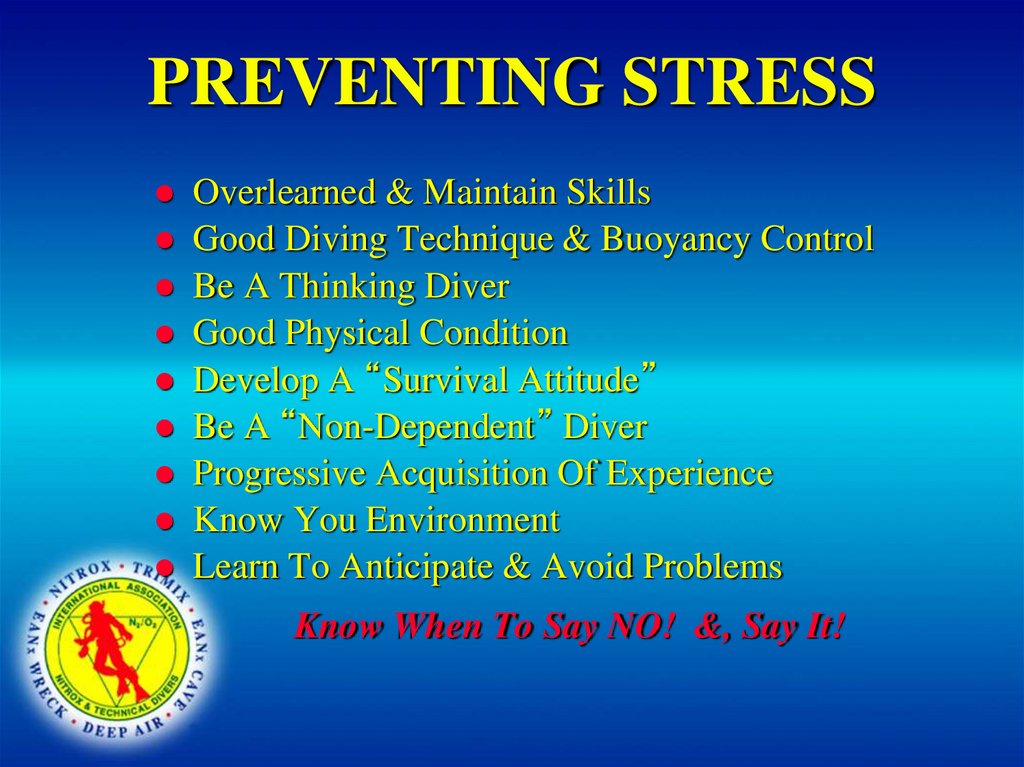


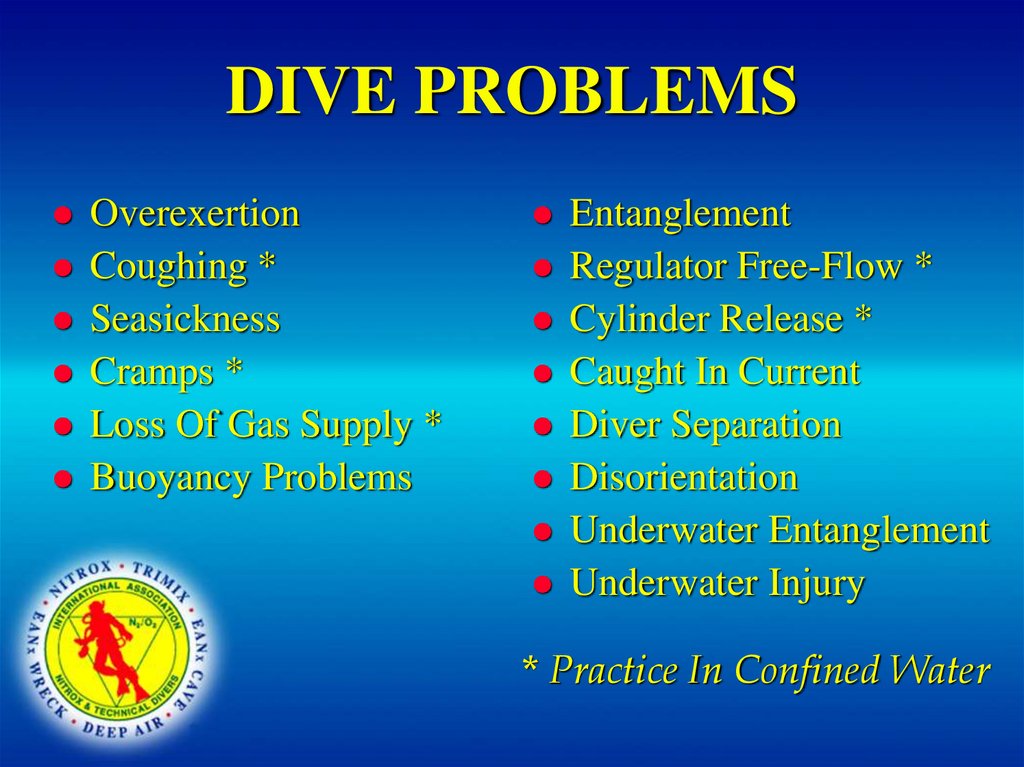


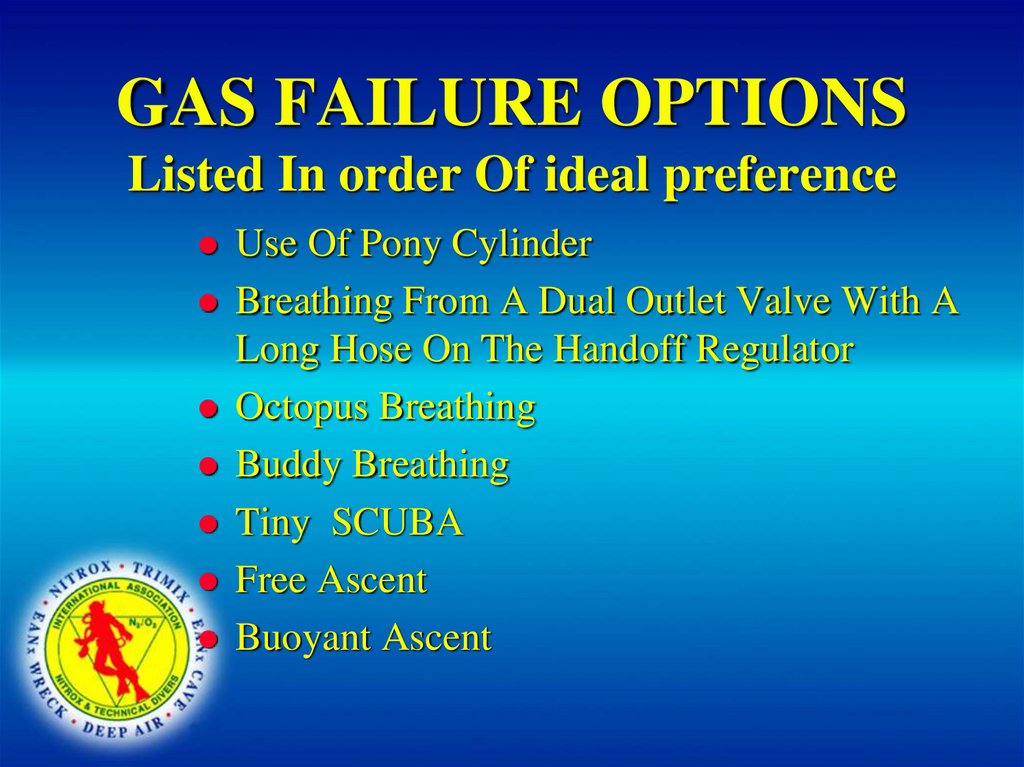



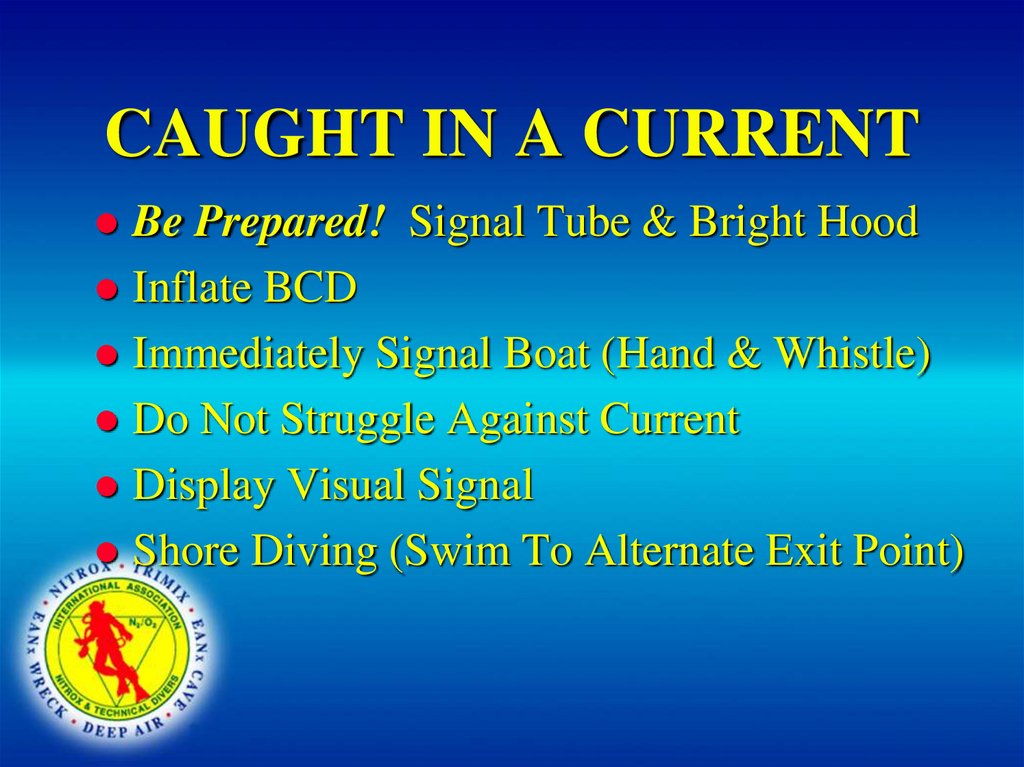
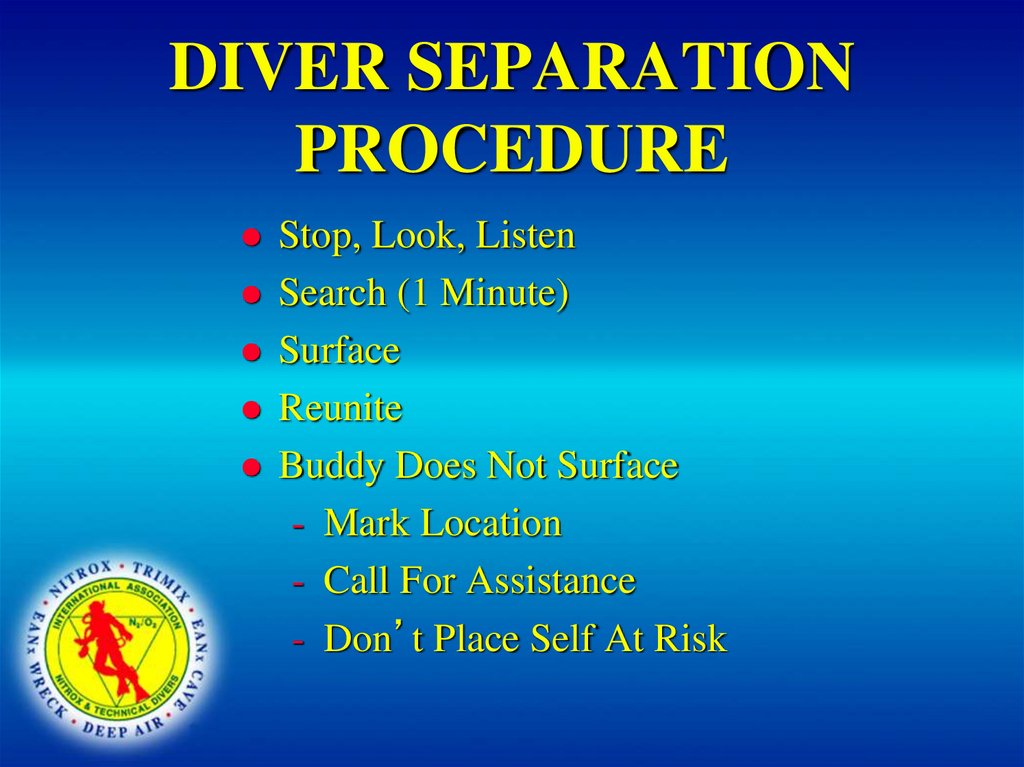
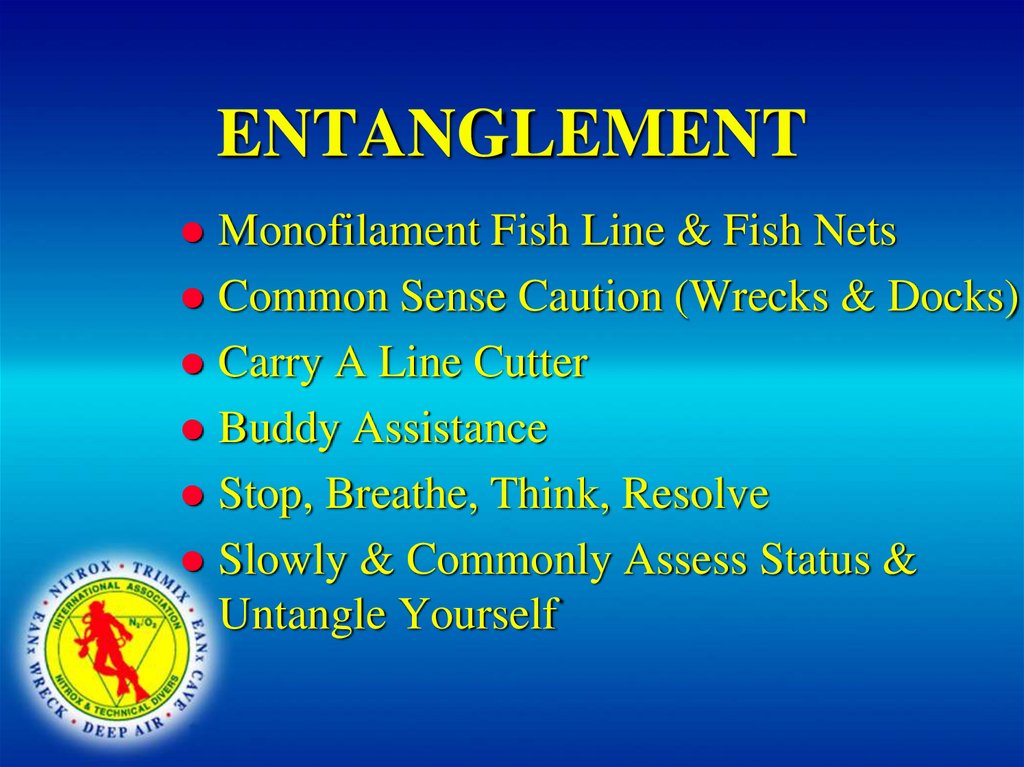

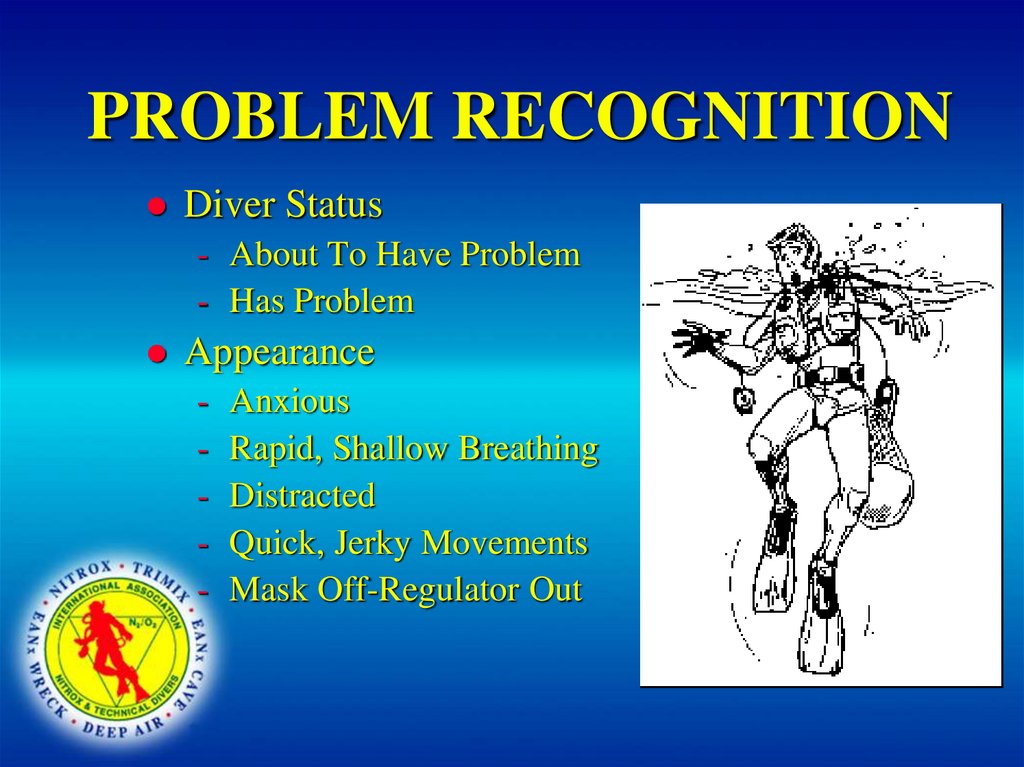
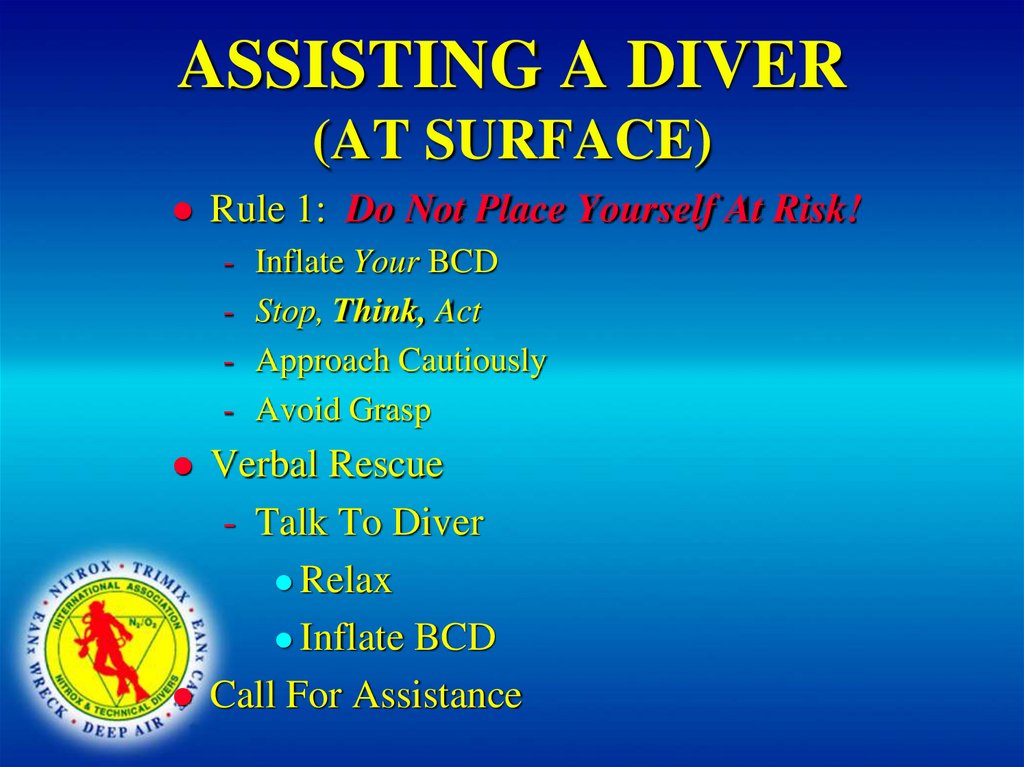
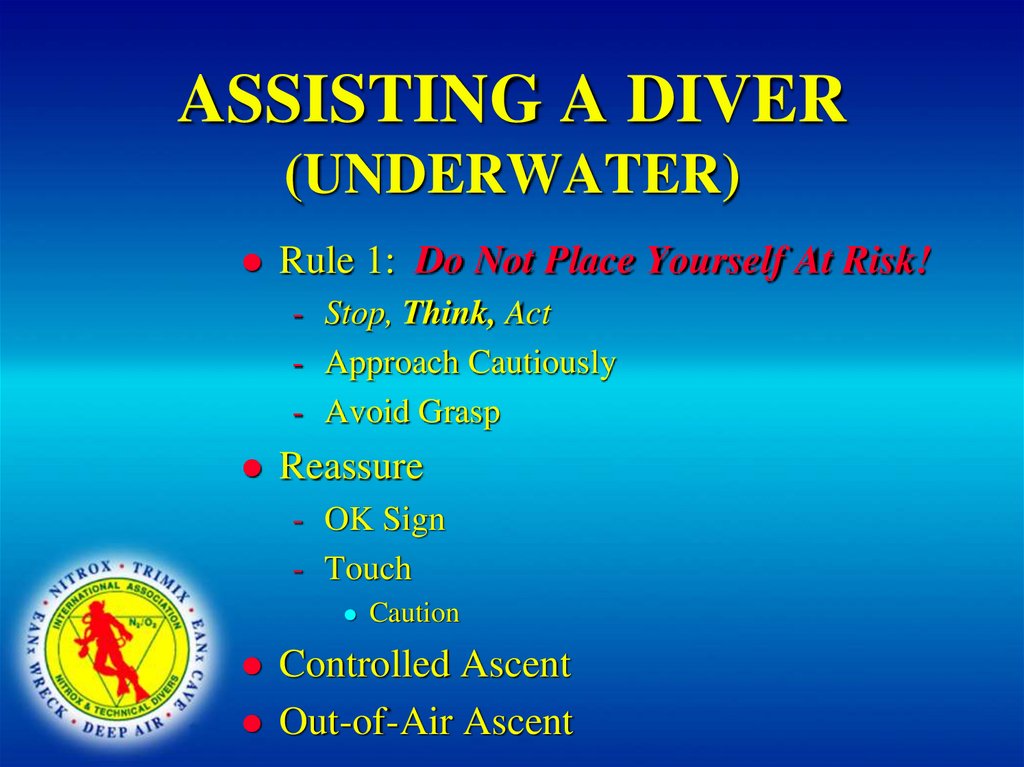

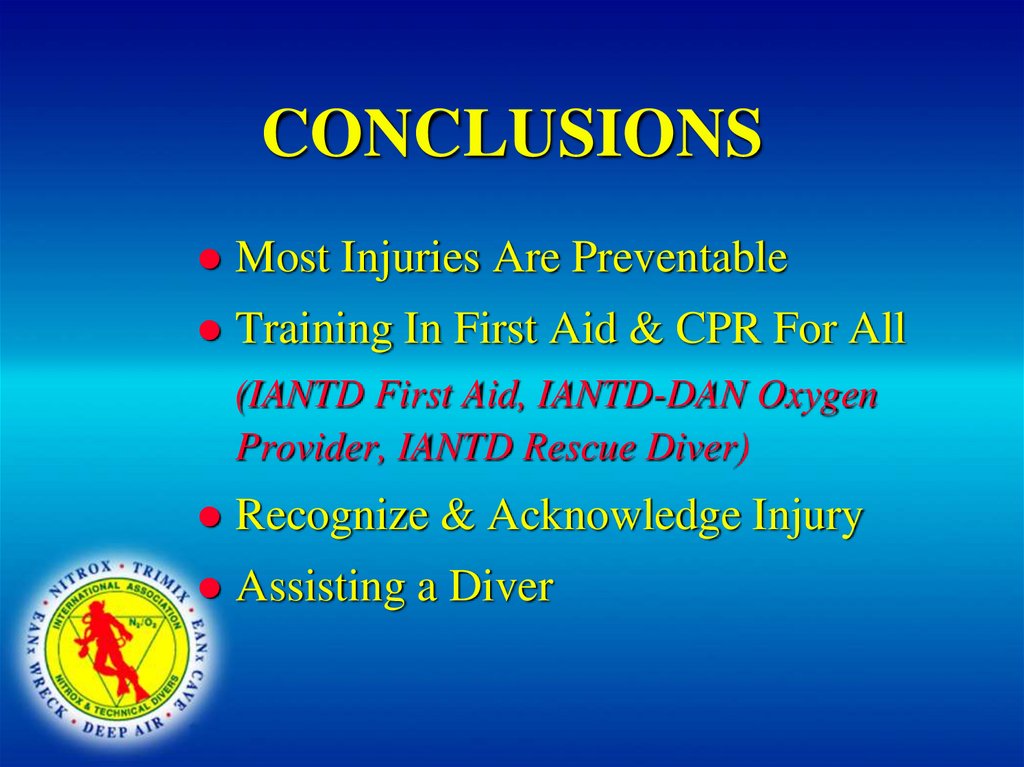


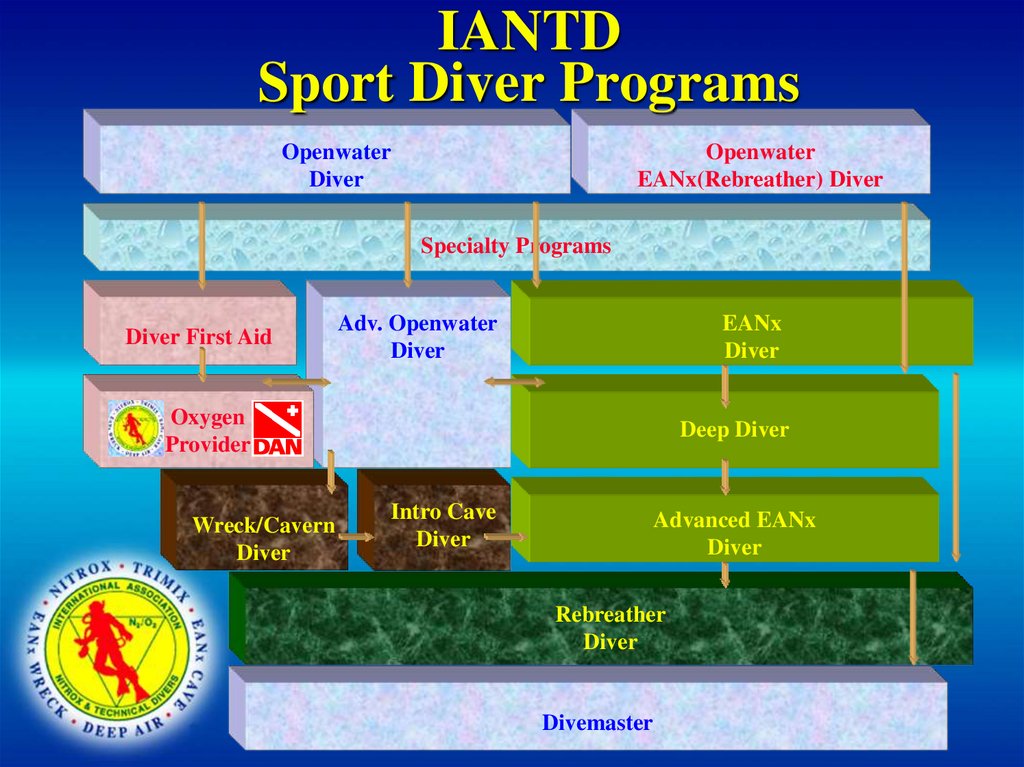
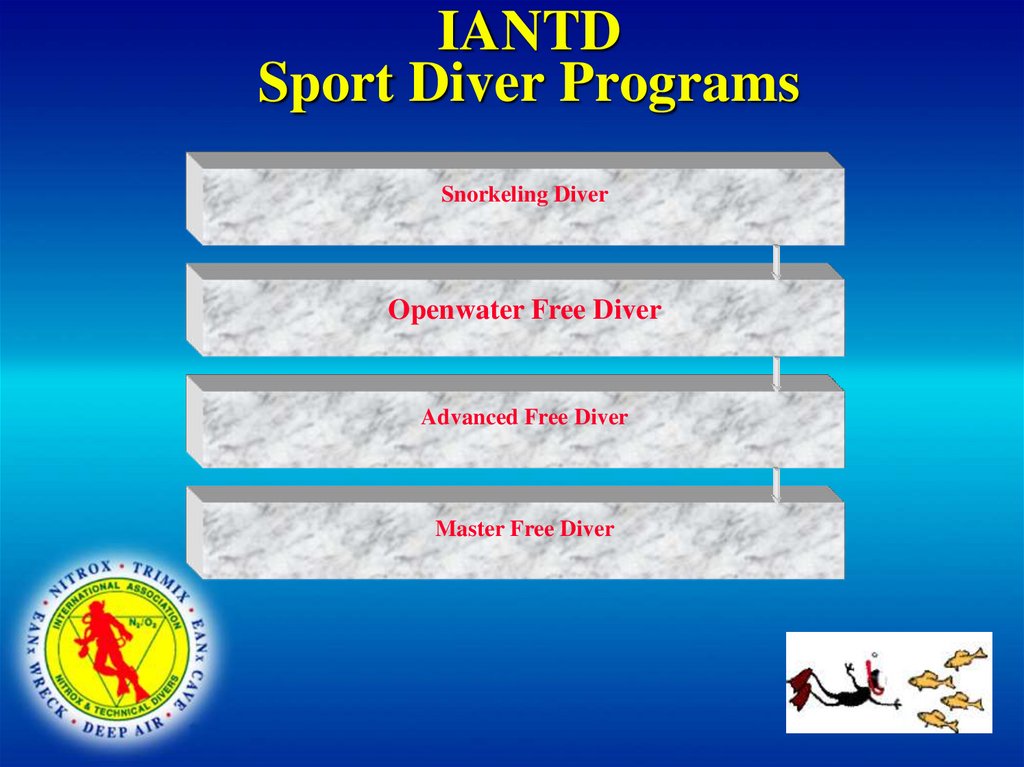


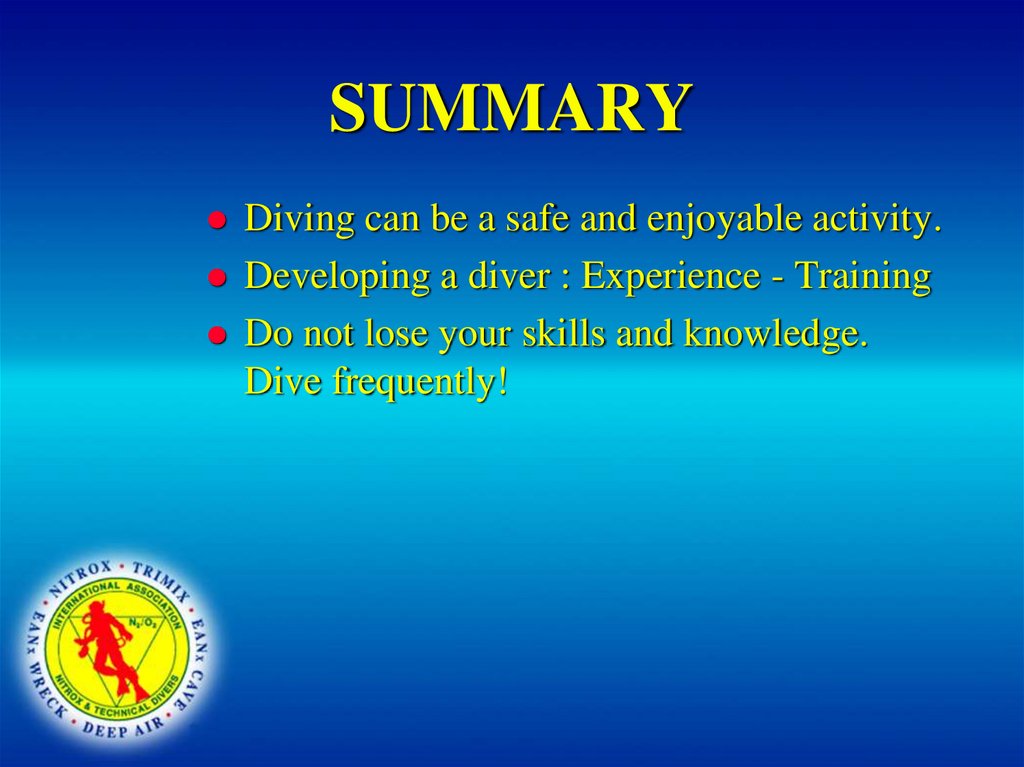
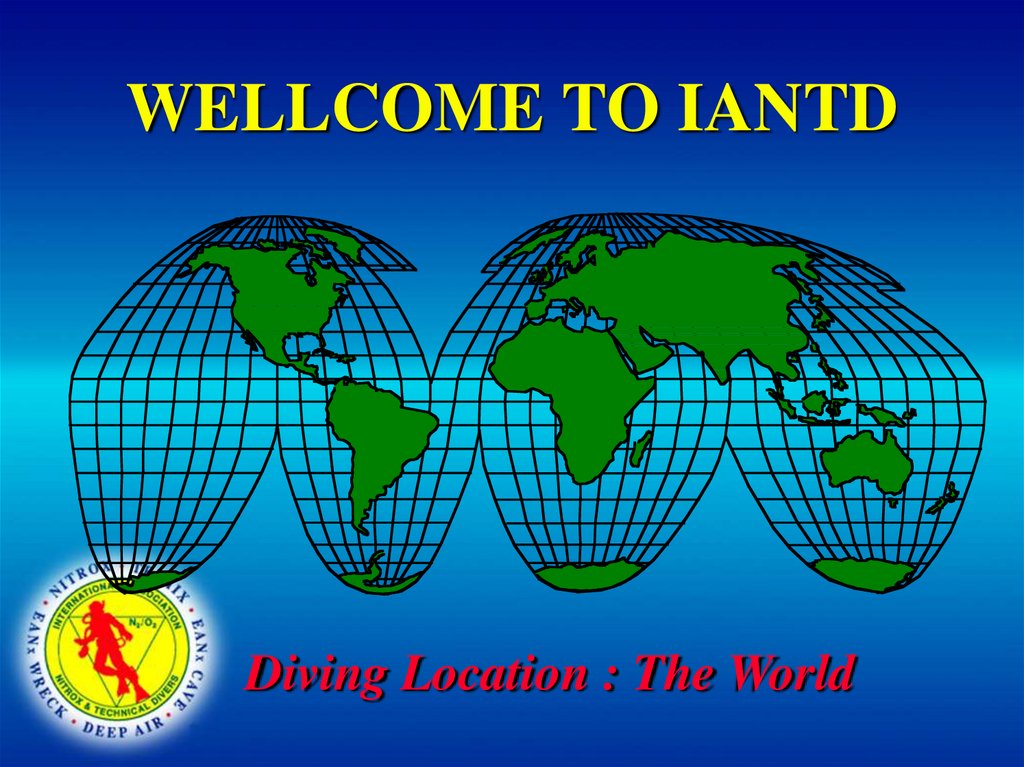
 sport
sport





